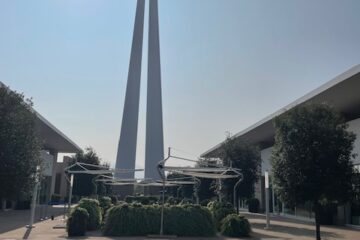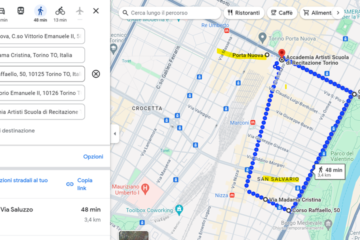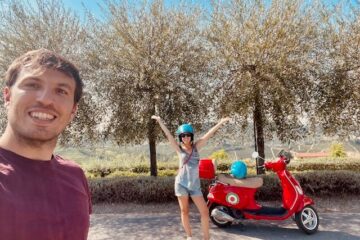Barbaresco Travel Guide / Best Local Tips/ Exciting beyond possible
This post may contain affiliate links. Please check our Affiliate Program disclosure for more information.
In this post you’ll learn how to have the most exciting tour in Barbaresco and the nearby UNESCO Langhe villages. We will share our unbeatable itinerary as well as great tips on what to do, see & eat. You’ll discover the best restaurants, wineries and panorama spots. You’ll learn a ton on what makes Barbaresco wine so great and key differences vs Barolo. Sit back and learn how to get a relaxing gateway, only 1 hour drive from Turin.
Quick Menu
- Why is Barbaresco village worth a visit?
- Where is Barbaresco & how to get there?
- Which are the 4 villages of Barbaresco?
- Langhe map explained: villages & grapes
- How far is Barbaresco from Barolo?
- Where to sleep in Barbaresco?
- Babaresco: local food not to miss
- Barbaresco village: our favorite spot for lunch
- Barbaresco village: fancy dinner tips
- Barbaresco’s Tower: view from the top
- Barbaresco: best wine tasting tour
- What is Barbaresco wine?
- Barbaresco vs Barolo: key differences
- Events in Barbaresco not to miss
- The Beautiful nearby village of Neive
- Tips for one afternoon in Alba Italy
- Useful links
To learn how to complement this trip with other amazing experiences nearby, you may want to check my other posts:
- If you want to learn more on Barolo here is the Unforgettable Barolo wine tour on a Vespa
- if You are heading to Turin, discover the city with the Perfect One-Day guide from a local
- if you fancy the beach, you may want to read The Best Beach Weekend from Turin
Hope you’ll find this content useful!
1. Why is Barbaresco village worth a visit?
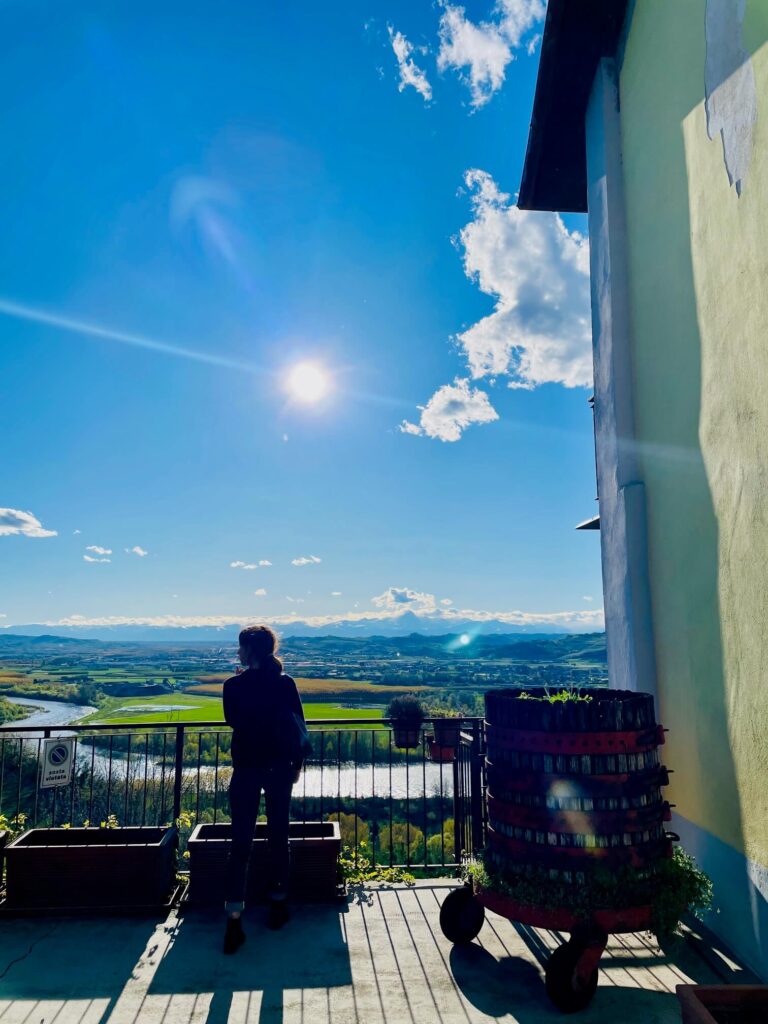
Barbaresco is a stunning little village in the middle of the UNESCO Heritage site of Langhe vineyards.
It is definitely worth a visit for everyone who is looking for a short escape from the city to wind down and relax with some great landscape views, incredible food and unparalleled wine.
Wine experts & foodies will absolutely love it here, but I think it really is an attractive gate-away for the broader audience.
In terms of views it is somewhat spectacular, it is surrounded by gentle hills covered with vineyards stretching as far as the eye can see. Furthermore, you can see quite neatly the Alps in the background which is really impressive. One can easily identify the Monviso and Monterosa mountains.
The view on the Alps is a unique point of difference which I’m sure makes the Barolo guys really jealous.
2. Where is Barbaresco and how to get there?
2.1 Where is Barbaresco village?
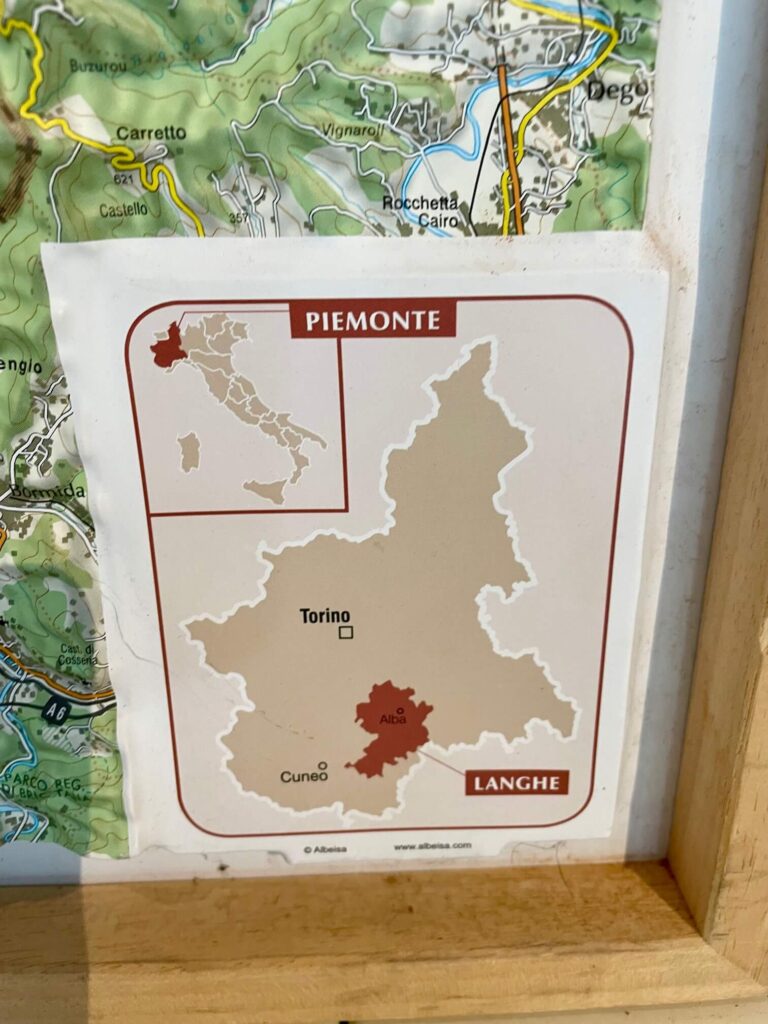
Barbaresco is located in the northern part of the Langhe vineyards UNESCO Heritage site.
For the ones who are not very familiar with the area, the Langhe vineyards are part of the Piedmont region which sits in the North West side of Italy, as you can see on the top right corner of the map above.
The closest and most popular city to Barbaresco and the Langhe region is Turin, which in Italian is called Torino, which is the city of FIAT and Juventus. Barbaresco is roughly a 1 hour drive south of Turin.
Let me point out however that the closes city to the Langhe region is actually Cuneo. This why Barbaresco and all other villages within the Langhe area are part of the province of Cuneo, not the province of Turin.
2.2 How to get to Barbaresco village?
The easiest way is to fly to Turin or to Cuneo airport. Our advice is to then rent a car and drive to Barbaresco.
Public transportation in the Langhe is not that great, so we don’t recommend to get there by train nor by bus.
If you’re landing in Turin, we’re talking a bit more than a one-hour drive (70 km). You can either take the Torino Savona (A6) highway but you’ll need to pay ~20 eur tolls for a return trip or you can take the slower road the Strada Statale SR29 which passes through Poirino and Pralormo.
BONUS TIP: The latter will be free of charge, will take you the same amount of travel time. Plus you can see the Tulip garden!
We recommend the second option as you will avoid traffic jams, it is cheaper and you can make some interesting stops along the way.
We took the opportunity to visit the beautiful Castle of Pralormo and given that it was the right season we also managed to see the Castle’s breath-taking Tulip gardens.
If you want to learn more about Pralormo’s Tulip gardens and castle, you may want to read my other post Unexpected Beautiful day in Pralormo’s Castle & Tulip Gardens.
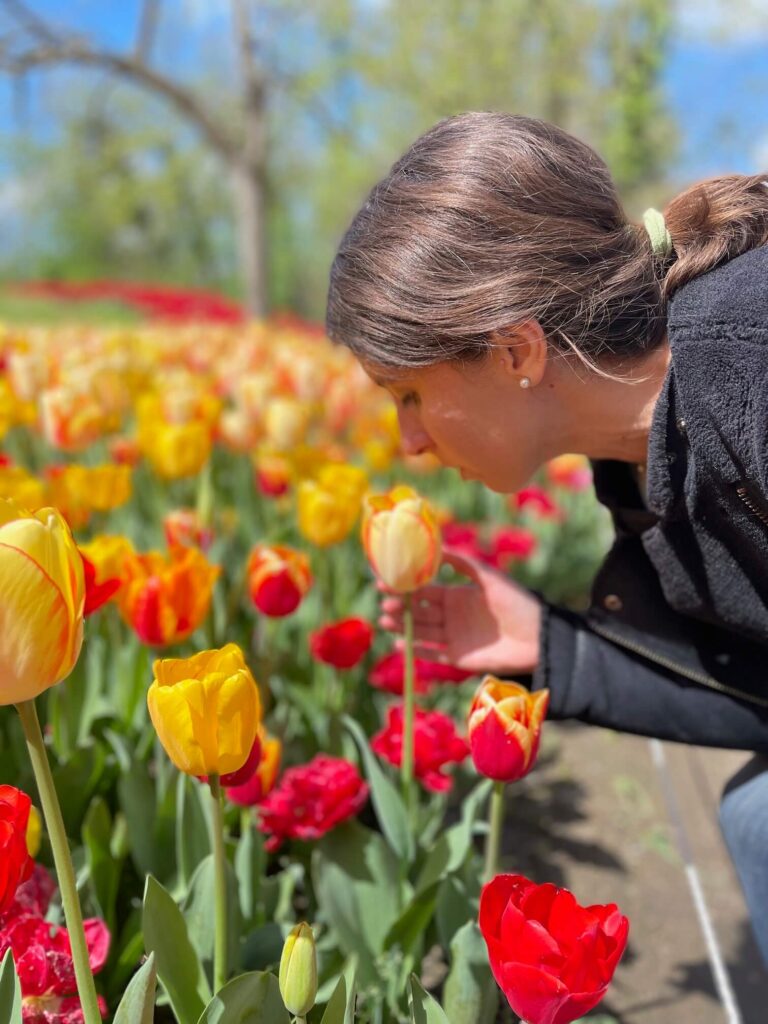
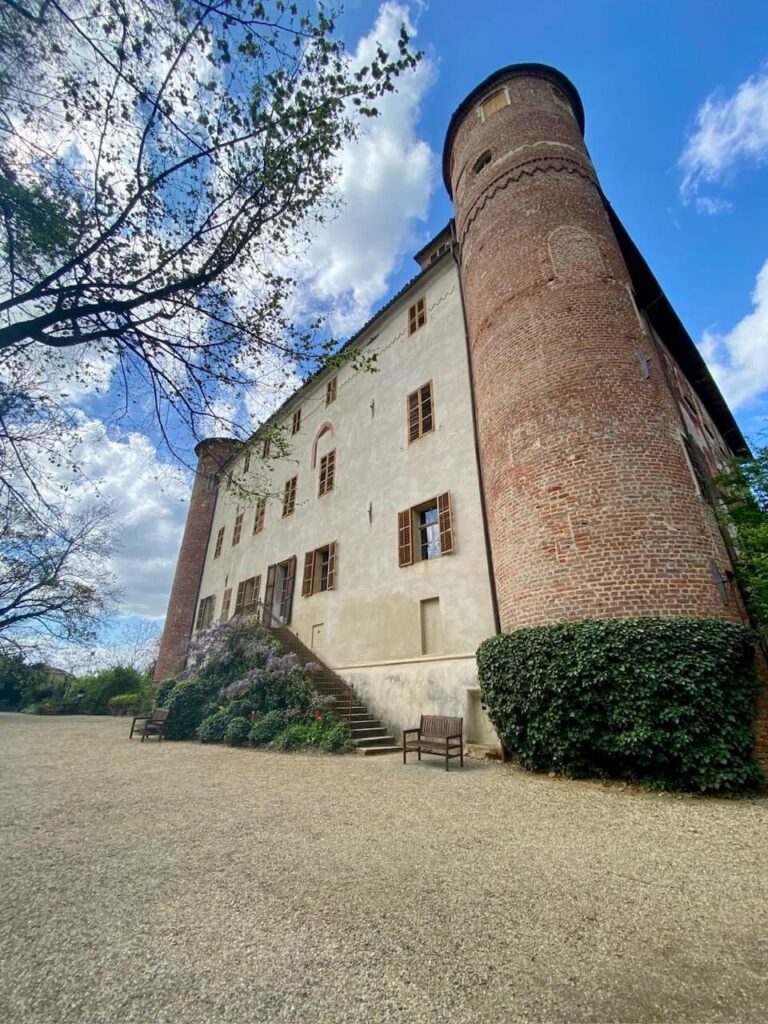
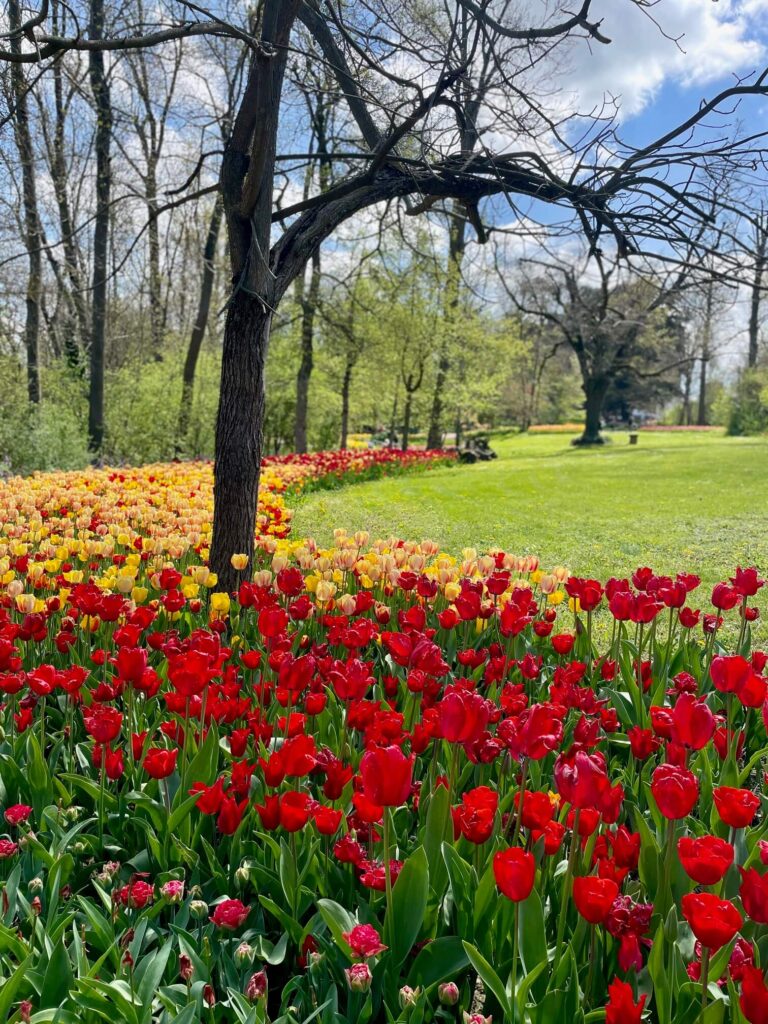
3. What are the four villages of Barbaresco?
The area producing the prestigious Barbaresco wine is limited to four little towns:
- Barbaresco village
- Neive
- San Rocco Seno d’Elvio, an area within the famous city of Alba
- Treiso
Neive is a beautiful Mediaeval village which is only 7 mins drive from Barbaresco village, it is definitely worth visiting. You’ll get more info on Neive later on in this post.
We didn’t specifically go to San Rocco as we preferred to visit the city of Alba. I think we did the right choice. It is absolutely a no miss, you will learn more on Alba throughout this post.
We haven’t been to Treiso as we’ve heard it is not worth it. It was rebuilt in the 70s so it doesn’t have a lot of charme.
4. Langhe Map: Villages and grapes explained
4.1 Villages: Barbaresco, Barolo and Roero
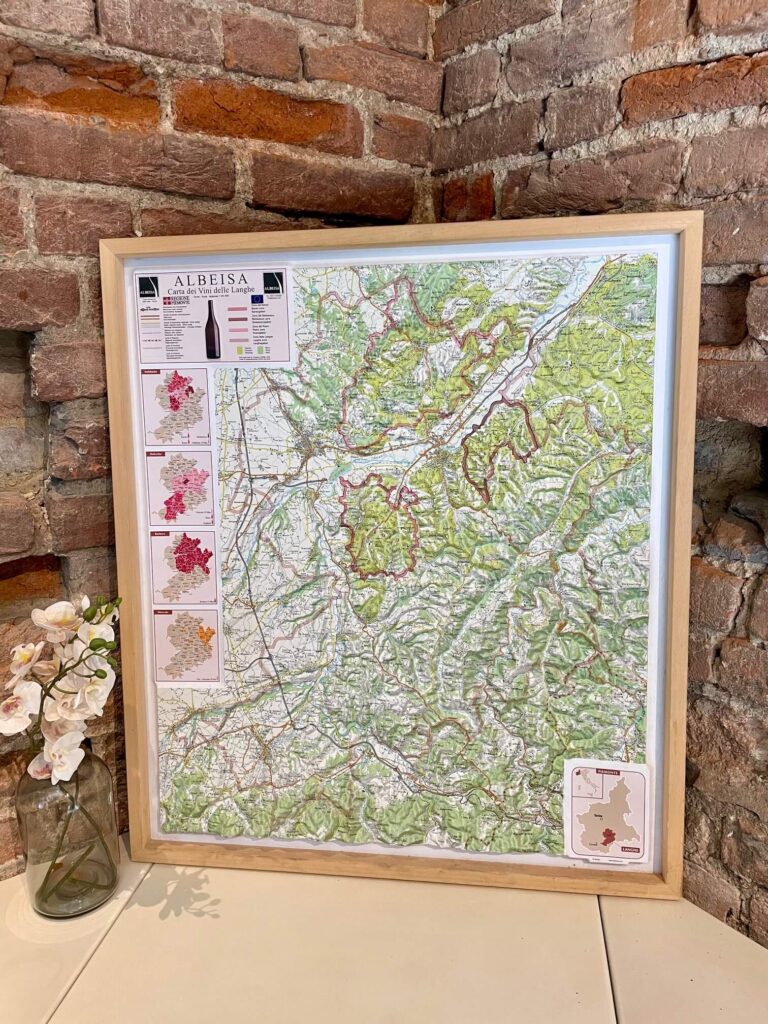
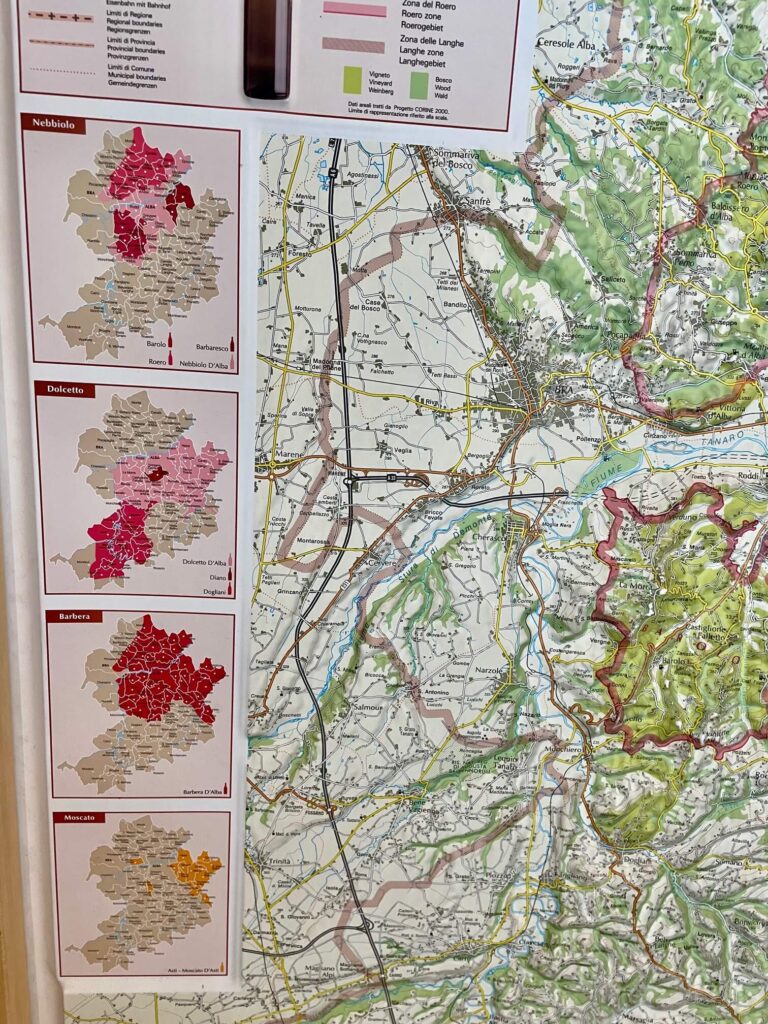
On the picture above on the left side, you can see a close up of the Langhe map where it is highlighted the Barbaresco area, the Barolo area and the Roero area.
The big region at the top is called Roero. This is also a wine district, but it is mainly famous for their white wine called Roero Arneis.
As you can see the Tanaro river is what separates the Roero area on the north of its banks from the Langhe area on the south. South of the Tanaro river you can see highlighted on the right the Barbaresco area and on the left the Barolo area.
On the west side of the map sits the Monferrato area, the most famous city here is Asti.
4.2 Grapes: Barbaresco, Barolo, Dolcetto and Moscato
On the picture on the right side above, you can see a close up of the Langhe map where the different grapes are highlighted.
In this area, we have four different grape varieties: Nebbiolo, Barbera, Dolcetto and Moscato.
The two most prestigious wines of the area are by far the Barolo and Barbaresco wine. They both take their name from two beautiful villages in the area. Both are made 100% from Nebbiolo grape.
Please note that in the Barolo and Barbaresco area you will also find some Barbera and Dolcetto grape!
As you can see from the map, the Nebbiolo grape sits only on the northern part of Langhe particularly the area of Barolo and Barbaresco.
The Barbera grape, which is used to make Barbara d’Alba is a good red wine though less renowned. As you can see from the map this grape is present also in the Barolo and Barbaresco villages but covers a much wider area than Nebbiolo. Barbera wine is much lower in tannins and much more acidic.
You can also find Barbera wine outside of the Langhe area, specifically in Monferrato. In such case, the wine takes the appellation of Barbera d’Asti instead of Barbera d’Alba.
From the map you can see that the Dolcetto grape, which is a pretty decent but less prestigious wine, sits at the center and at the South of Langhe.
Finally, on the East side there is the Moscato grape from which you make the Moscato d’Asti. This is just outside of the Langhe region, as mentioned earlier this area is called Monferrato. Moscato d’Asti is a sweet sparkling white wine which pairs incredibly well with desserts.
5. How far is Barbaresco from Barolo?
Barbaresco is 24kms away from Barolo. Given the hills and slow countryside roads, it will take you 20-30 minutes by car to get from Barbaresco to Barolo.
If possible, we recommend to visit the Barbaresco and Barolo in two different trips so you can stop over and make the most out of the beautiful little towns that surround them.
Below you will find our recommended itineraries to make the most out of this beautiful region.
5.1 Barbaresco wine area – itinerary
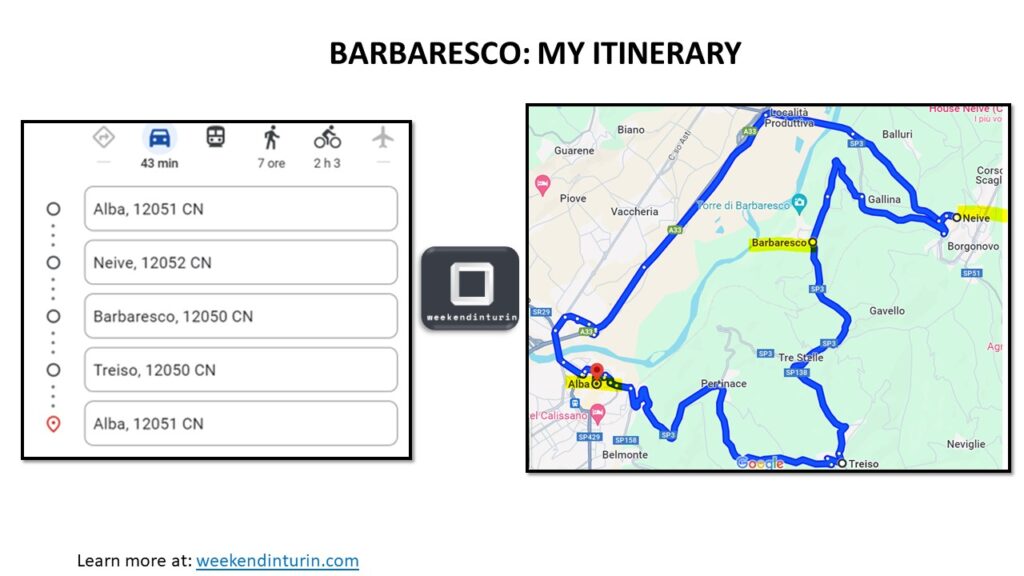
As you can see from the picture above, the full Barbaresco wine area itinerary will be in total a 45 mins drive. The most important stopovers here are: Barbaresco Village, Neive and Alba.
In Barbaresco village, you absolutely need to go up to the tower in the old town to admire the view and do some wine tasting on the sunny terrace of Casa Boffa.
In Neive there is a fantastic square, the Big Bench and a really nice Panorama spot. There is a nice sandwich shop with local delicacies to recharge the batteries in a very time & cost-efficient way.
In Alba you cannot miss the San Giuseppe Church and the view from its bell tower at the top. Being the capital of the prestigious White Truffle, you should also visit the Truffle Museum.
5.2 Barolo wine area – itinerary
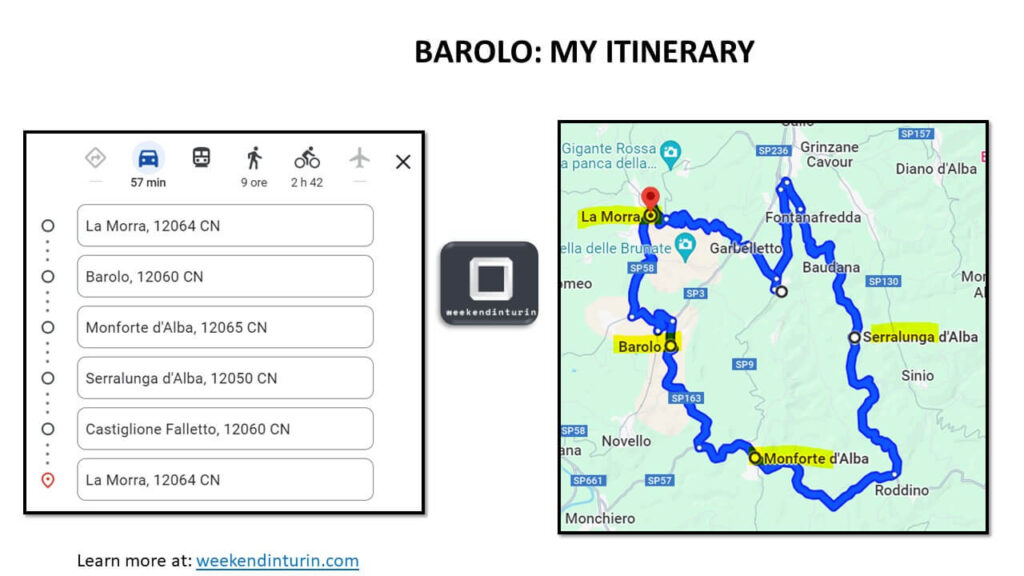
As per picture above, the full Barolo wine area itinerary will be in total a 57 mins drive. The most important stopovers here are:
- Barolo village
- La Morra
- Serralunga d’Alba
- Castiglion Falletto
- Monforte d’Alba
If you want to learn more about the perfect Barolo wine tour, you can read more on my post Unforgettable Barolo wine tour on a Vespa.
6. Where to Sleep in Barbaresco?
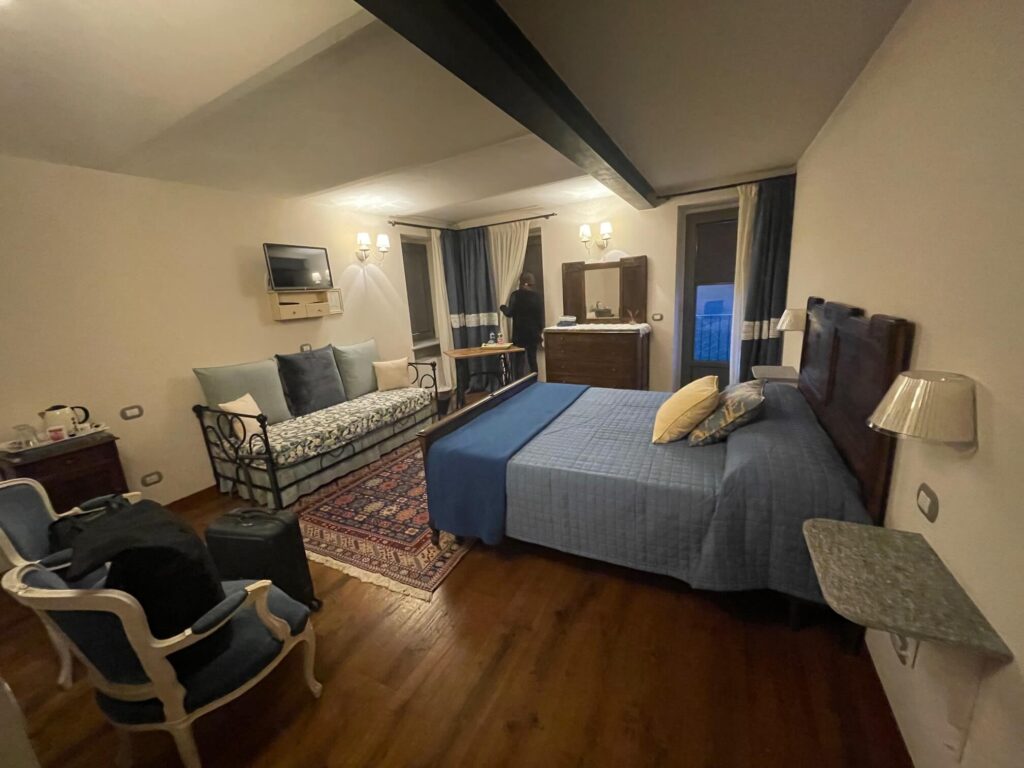
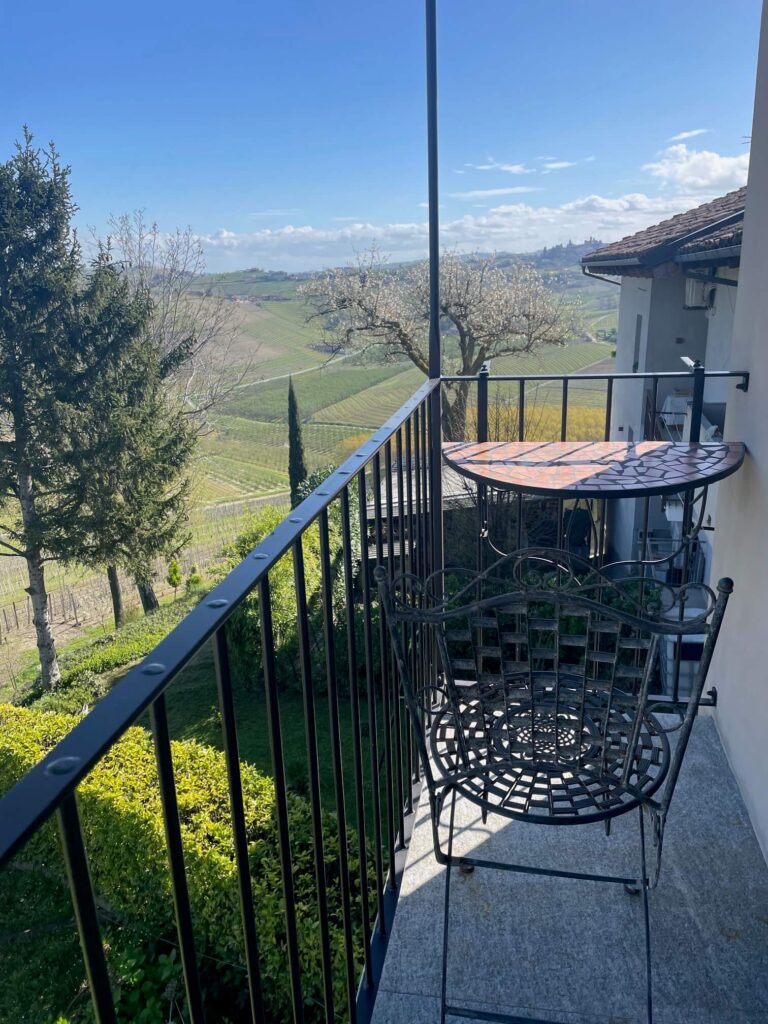
There are tons of great locations in the area where you can stay for 150 euro per night for a couple (75 euro per person).
We personally stayed at Agriturismo Rivella which at the time of booking was rated 9.4 stars on Booking.com. It was a really well kept farm house with a nice infinity pool overlooking the vineyards.
We took the biggest room which is called “stanza delle Meraviglie” which was quite spacious, comfortable and with a nice balcony overlooking the vineyards. We paid 150 eur per night in total breakfast included.
The downside was that all balconies are all facing north so there was no direct sunlight entering our room nor our balcony, we were not told upfront that the infinity pool (facing South & in the sunshine) was not accessible due to renovation and the host was not the friendliest.
All in all it was a good stay, you can see some pictures of the premises below, but I would encourage you to also look for other options.
7. Barbaresco village: local Food not to miss

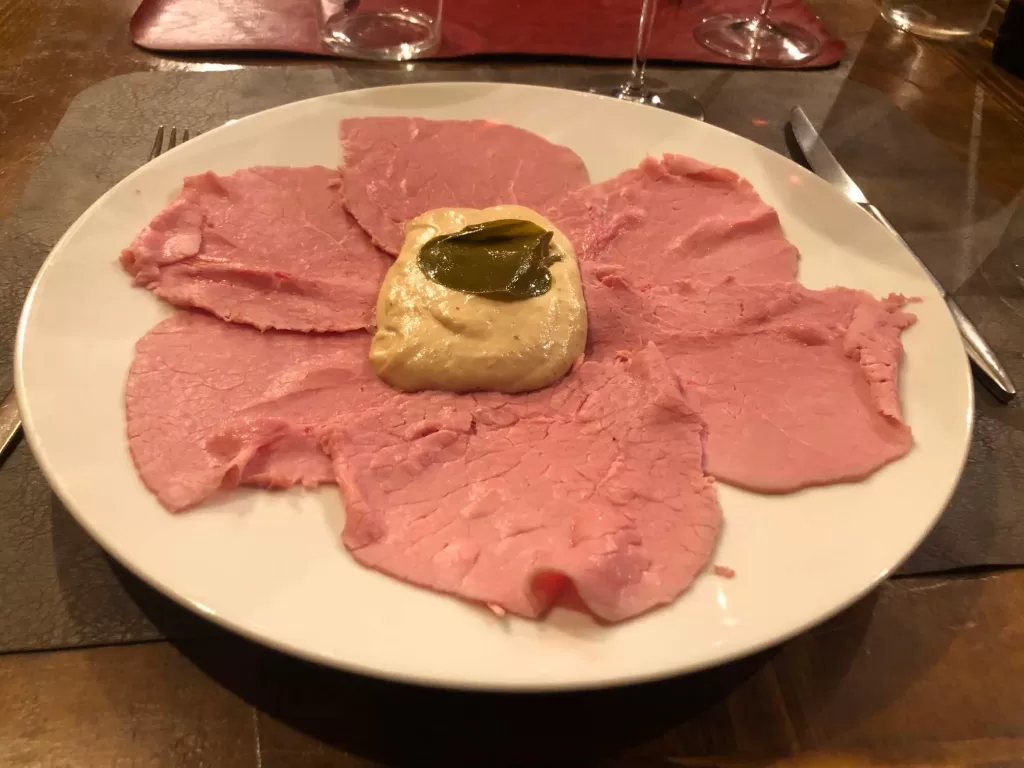
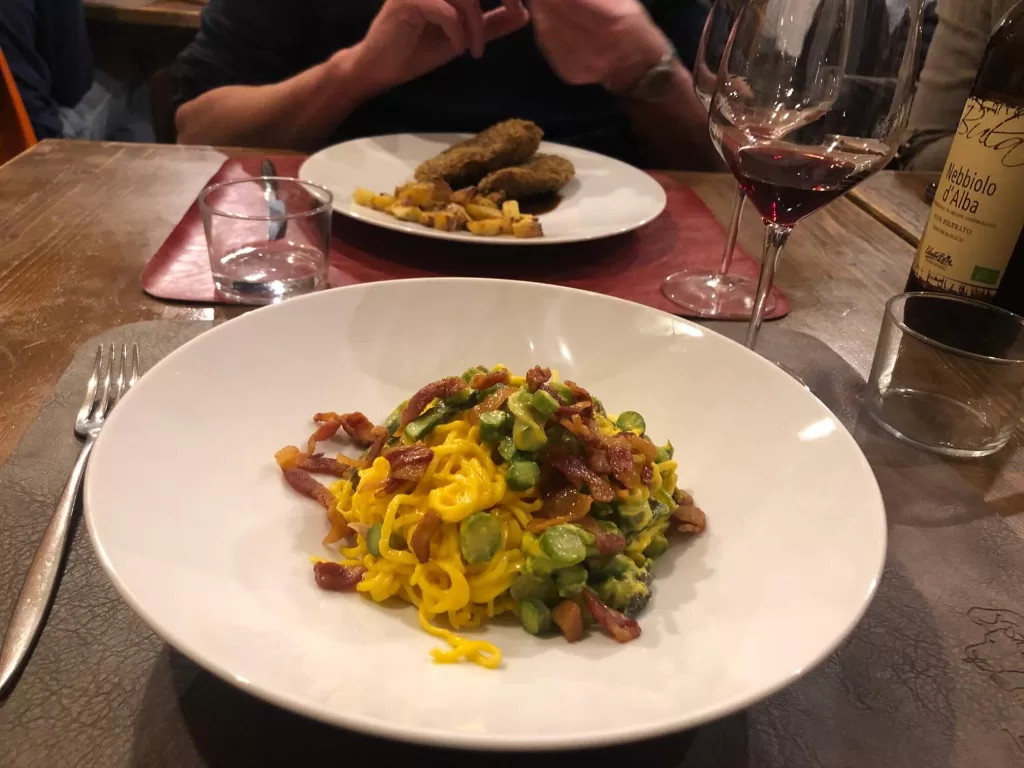
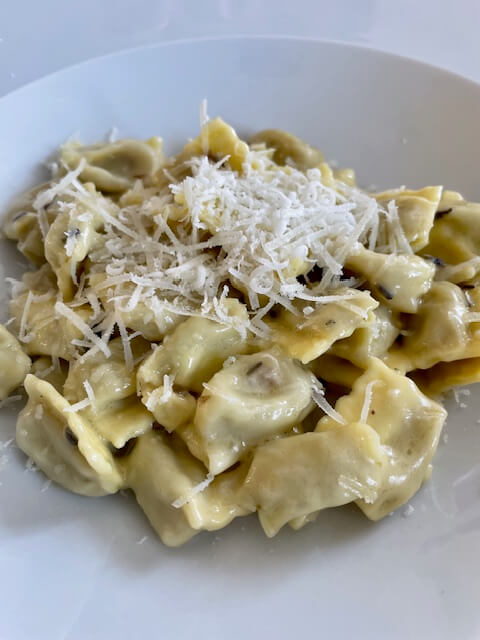
The best local food from the area hands down are: Tajarin pasta, Ravioli del plin, Battuta di Fassona and Vitello Tonnato. To help you better understand what to expect I put above one picture of each.
A typical delicacy from here is the Langhe hazelnut, if you ever come across anything with hazelnut make sure you try it! We took a hazelnut cake with Zabaione which was truly delicious, see picture below.
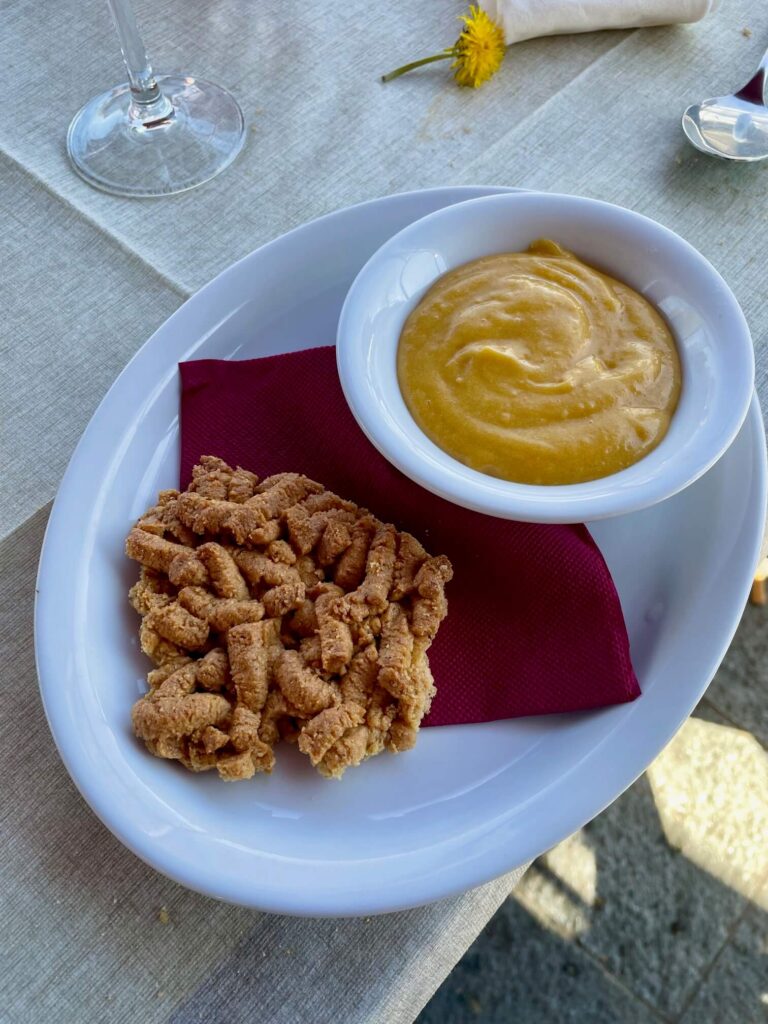
To learn more on typical food from the area, you can read my other post on Top 15 local food from Turin & nearby.
8. Barbaresco village: best lunch spot
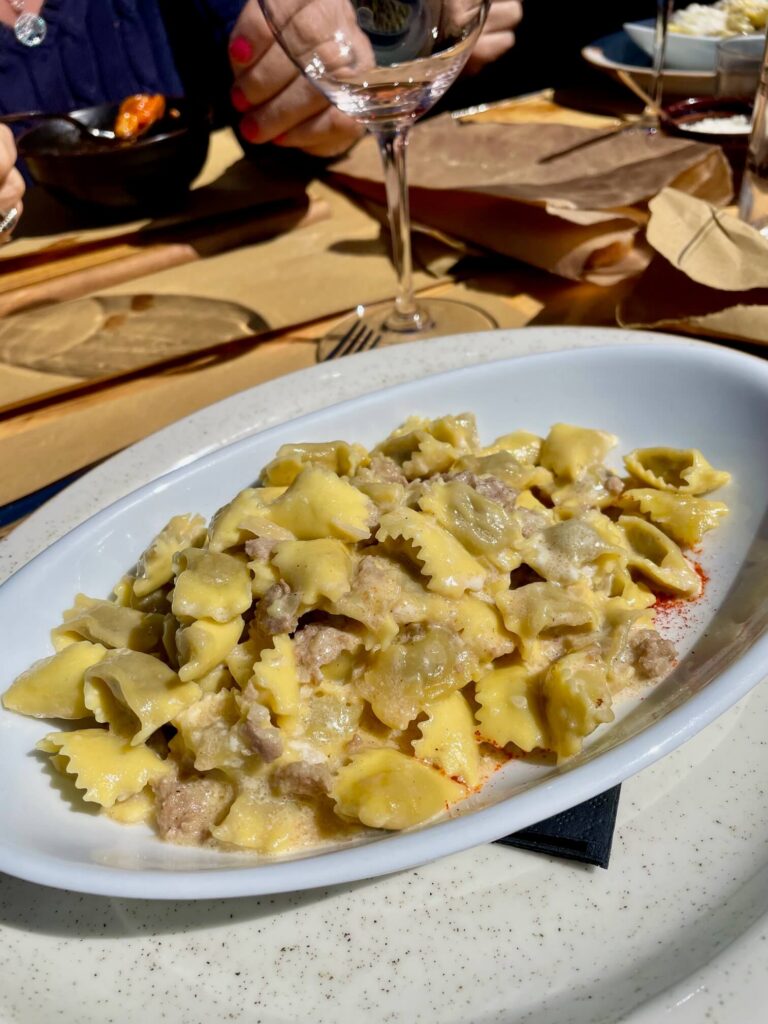
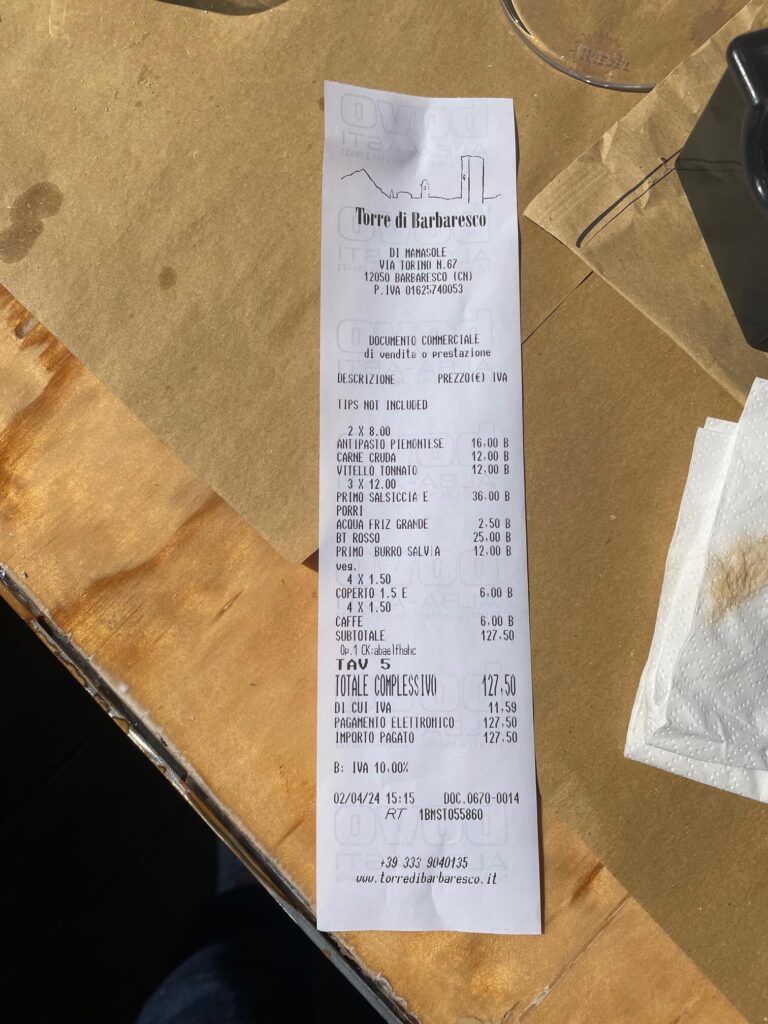
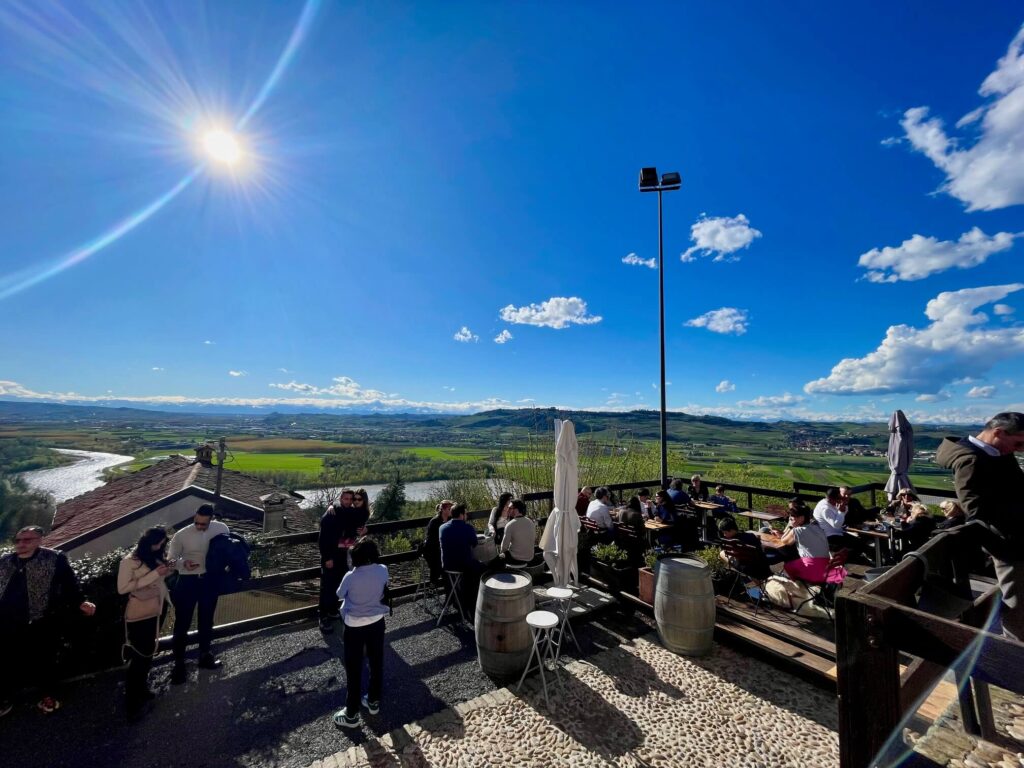
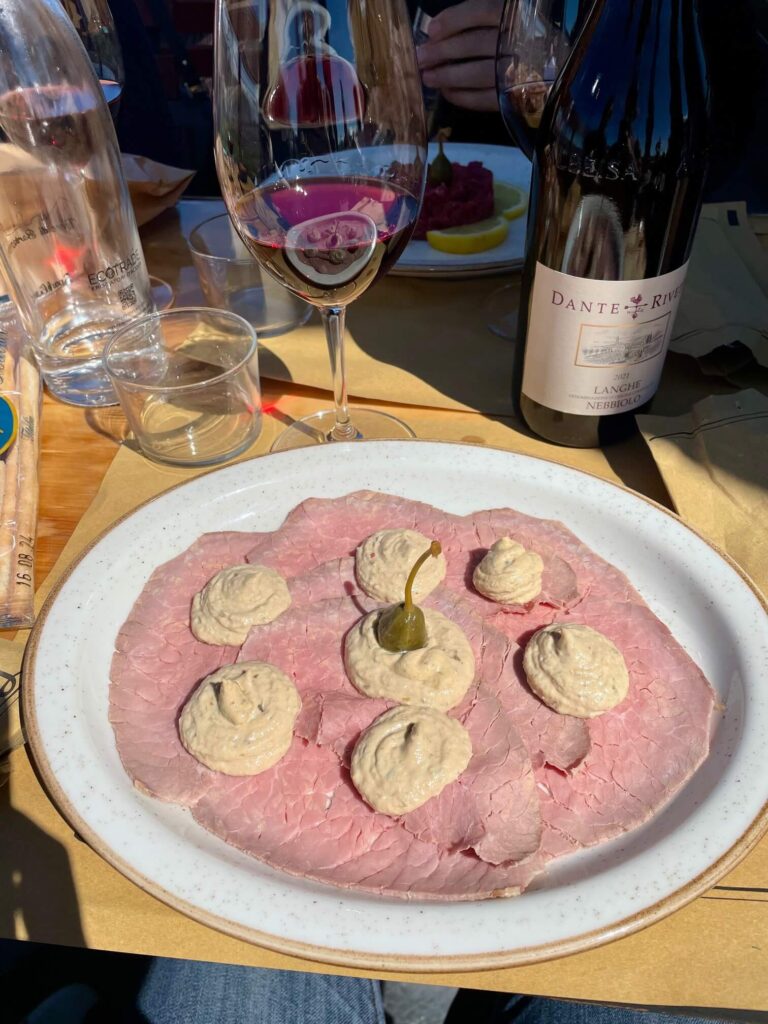
Our favorite lunch spot was the restaur ant at the bottom of the Barbaresco tower.
This place has it all: tasty local food, a sunny terrace with an incredible view on the vineyards and the Alps and affordable prices.
We were four people, we had two dishes each, 4 Espressos and a good bottle of Nebbiolo and we paid 127 euros in total (32 euros per person). See above pictures of what we ate as well as the receipt.
9. Barbaresco village: fancy dinner
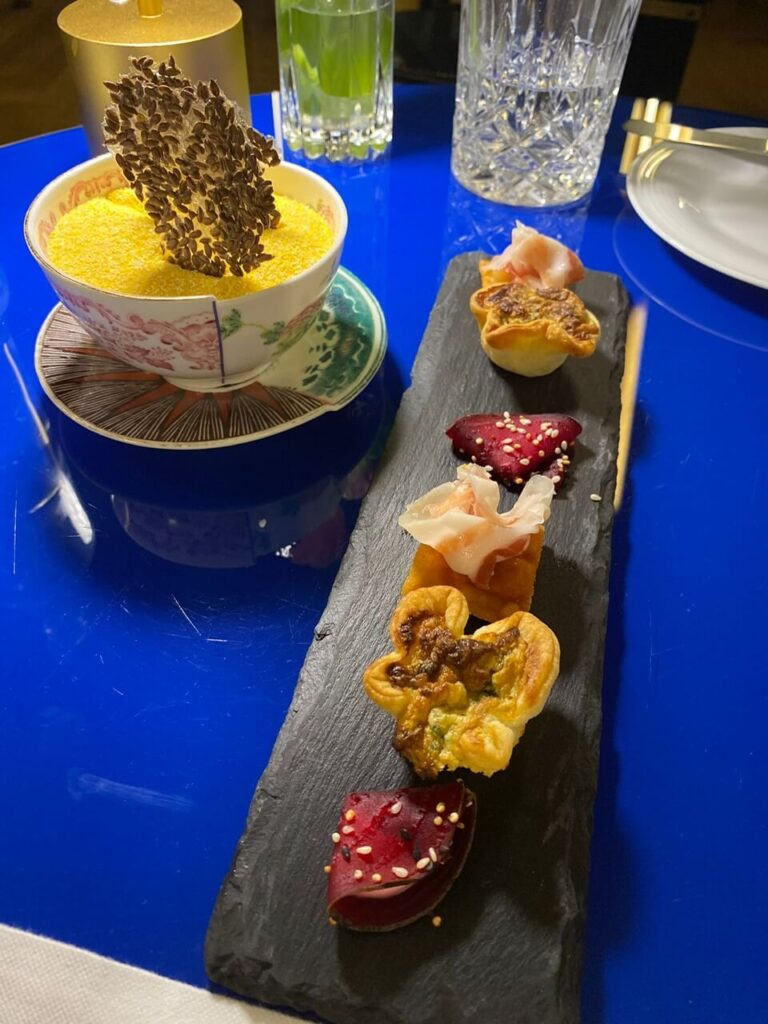
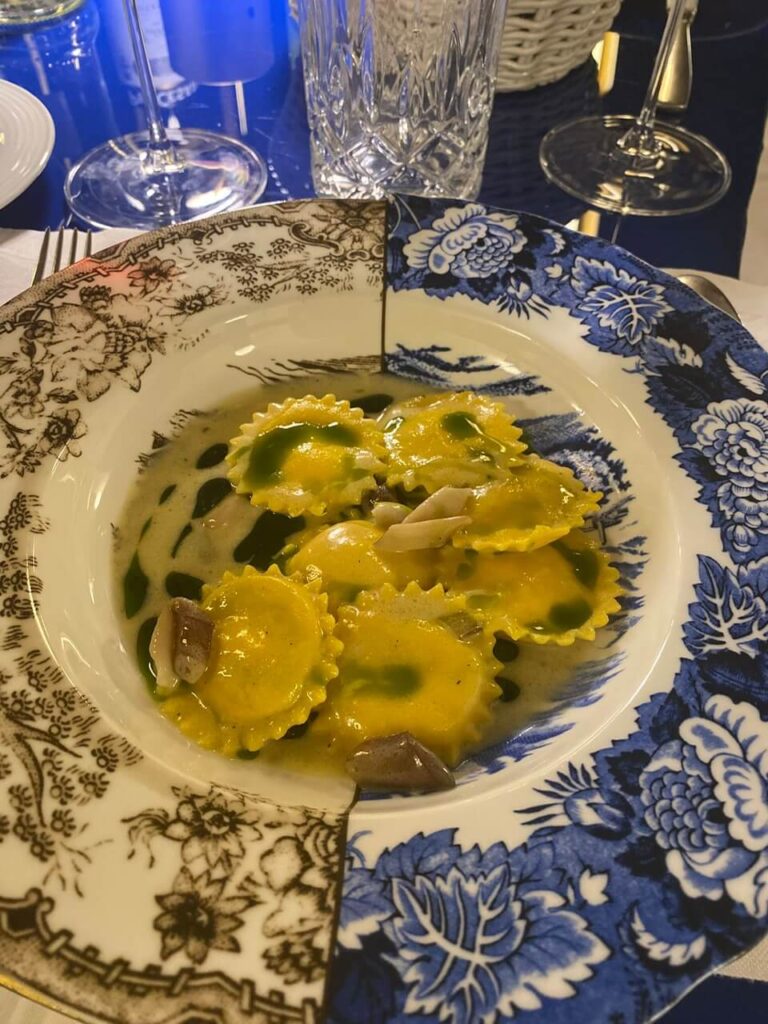
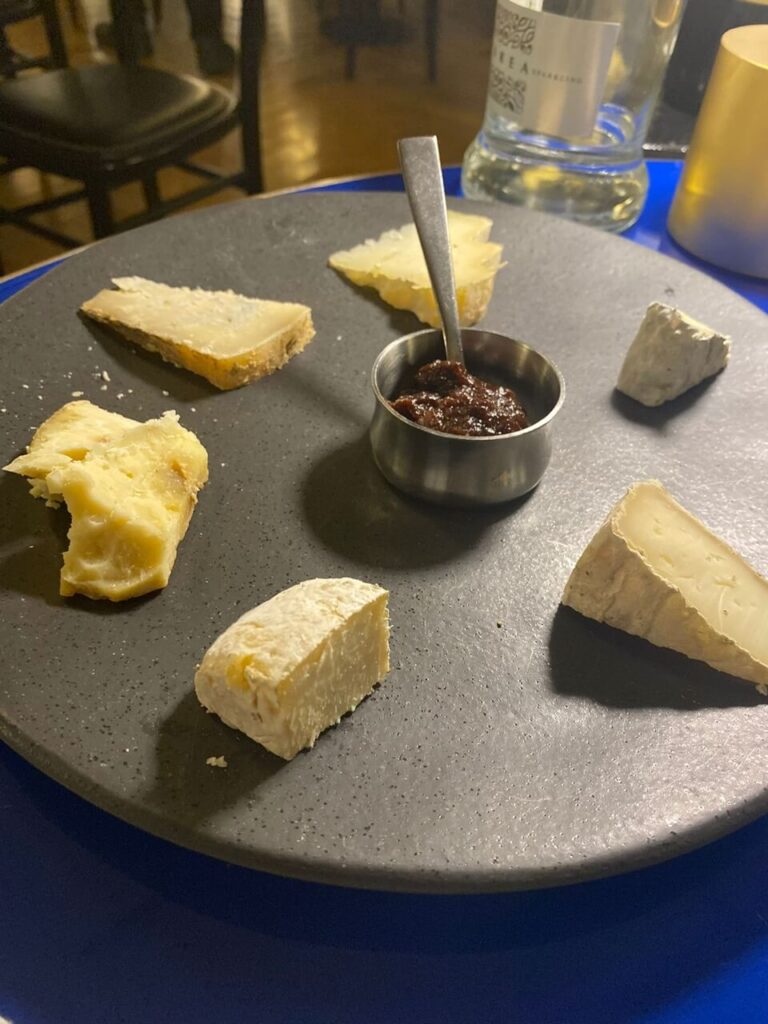
The nicest dinner was at Camapanac. It is a fancy restaurant on the pricier side. Very good ingredients, premium food selection/wine offering and impeccable service.
The cheese selection is fabulous, make sure you try that.
We were two people, we took two courses each a bottle of wine and a cheese platter of six cheeses and paid 140 euros in total (70 euros per person).
See above pictures of what we ate.
10. Barbaresco Village Tower
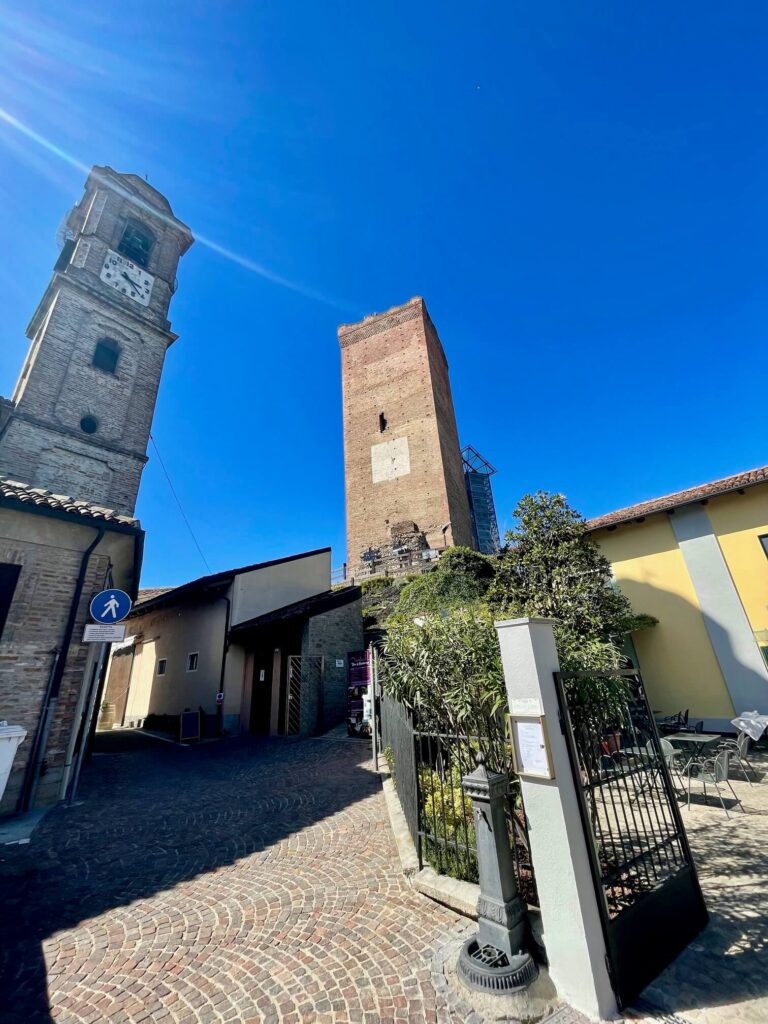
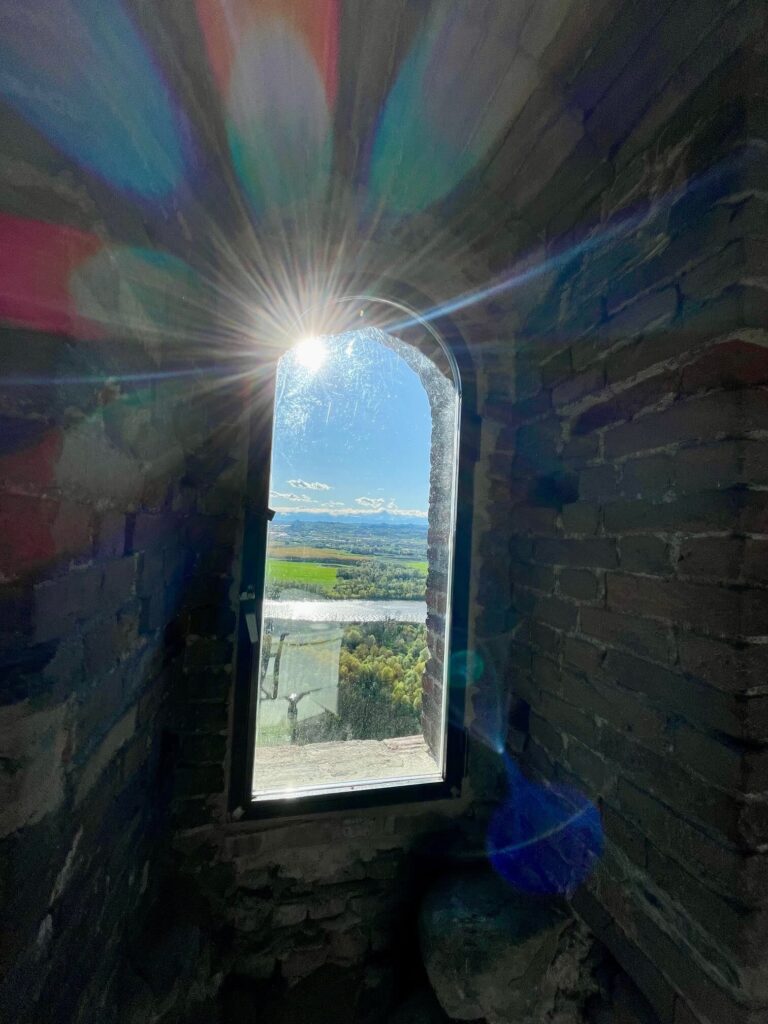
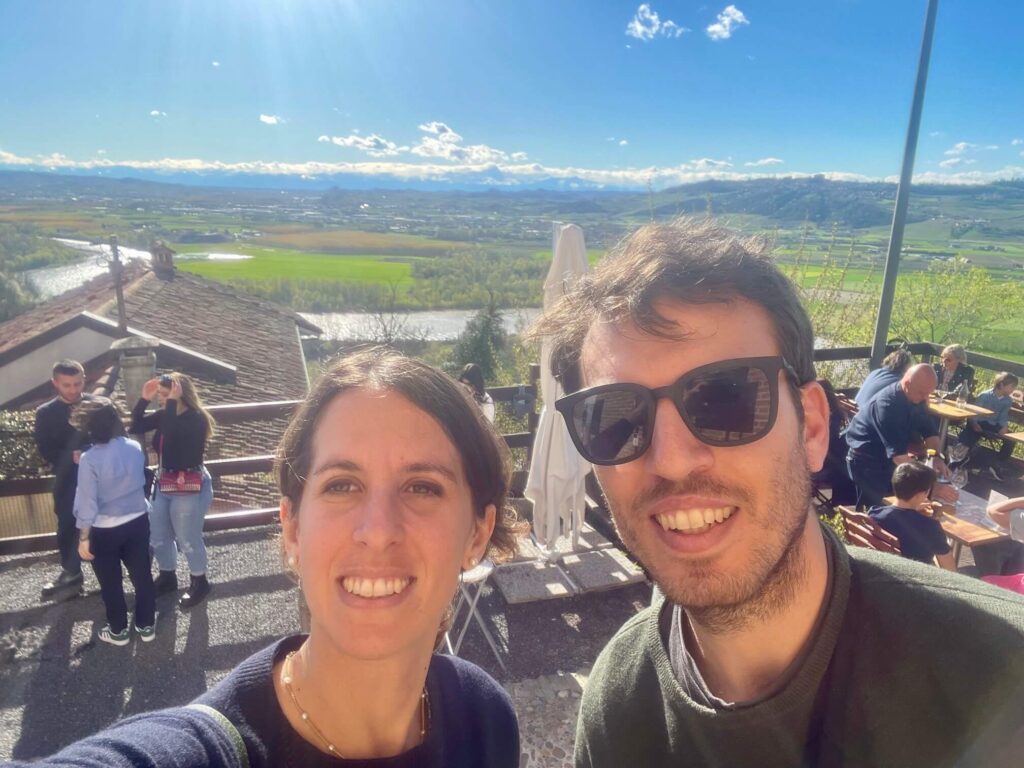
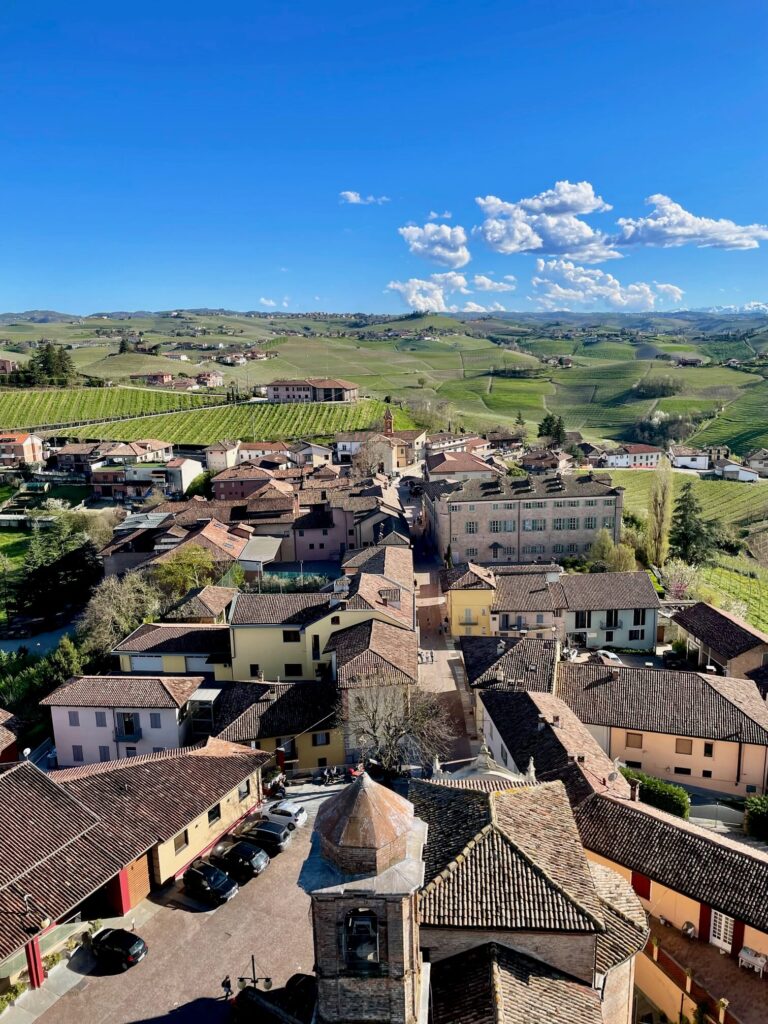
Make sure you climb the Barbaresco tower. The view from there is incredible, you can see the beautiful vineyards, the white Alps on the background as well as the Tanaro river which separates the Roero from the Langhe region.
On the background you can see the village of Neive, the Monviso mountain and Barolo.
The price of the ticket is only 5 euro per person and they will also give you a map to help you better understand the highlights of the panorama.
11.1 Barbaresco: Low cost wine tours
Regarding wine tasting, we suggest to go to Enoteca Regionale del Barbaresco.
This Enoteca represents approximately 140 producers which account for 90% of the yearly production of Barbaresco wine. Here you can find every day five different types of wines for wine tasting which are randomly selected in order to best represent the full spectrum of producers.
The Enoteca is located in Piazza Del Municipio and it is open seven days a week, here in addition to the tasting you can also of course purchase wine. Alternatively, you could also buy their wine online.
11.2 Barbaresco: The Best Organized wine tours
If you’re really serious about wine tasting, the best option is to go ahead with an organized tour.
I put a few options with different price ranges below to help you out. I haven’t had the chance to try any of the below, but based on ratings & reviews these seemed to me the best options.
Hope you find this handy.
Let me point out that I will make a small commission at no extra cost for you in case you decide to book tours from the link below.
12. What is Barbaresco wine?
12.1 the Nebbiolo Grape
Before going into details on the Barbaresco wine characteristic, let me spend a couple of words on the grape from which we make Barbaresco: the Nebbiolo grape.
As mentioned in the previous section, the most famous grape variety of the Langhe area is the Nebbiolo. Its name comes from the word “NEBBIA” which in Italian means fog.
The reason for that is that this grape matures very late in the season, back in the day it used to be in November and in that the period this valley was often covered in fog.
This is why the grape is called Nebbiolo!
Nowadays, due to global warming the grapes matures much earlier and the wine harvest occurs in September.
From Nebbiolo grapes you can make three different kinds of wines:
- Barolo, which is the most famous and it is often referred to as the king of Italian wine
- Barbaresco, can be referred to as the Queen, due to its elegance. As it is less known than Barolo but still of excellent quality it is “the Best kept secret” of the valley
- Nebbiolo, which is less popular but still in my opinion a great tannic red wine
All three varieties are made 100% from Nebbiolo grape.
12.2 Barbaresco wine in details
Barbaresco wine is 100% made from Nebbiolo grapes cultivated in four different villages: Barbaresco village, Neive, San Rocco Seno d’Elvio and Treiso
This area adds up to a total of 680 hectares. There are some strict restrictions on the number of liters of wine that can be produced per hectar in order to ensure that the taste of each grape is well preserved.
The maximum production allowed is 8000 L per hector which adds up to roughly 4,000,000 bottles per year. The Nebbiolo grape mature quite late in the year, the harvest typically starts end of September and it can last up to 3 weeks.
After the harvest, the wine is well kept in wooden barrel for minimum 9 months and then in bottle for a total aging of minimum 24 months in total. The wooden barrel needs to be Rovere wood.
The wine can be sold only starting January of the year following the harvest, this is why every bottle you will see will belongs to the harvest that occurred minimum 2.5 years earlier.
This wine is already very pleasant after 2.5 years but it ages very well, bottles can be kept in your wine cellar up to 25 years.
The wine colour is garnet red with some orange reflections. The aromas are complex but very well balanced, you can detect notes of rose, apple, cherry, peach, vanilla, cinnamon, tobacco and licorice. Aromas and color will vary depending on the exact location of the vineyard (i.e sun exposure, altitude, and the minerals in the land) as well as to the wine’s age.
In terms of meals goes wrong very well with traditional dishes from the area such as meat starters, ragu pasta, aged cheese as well as slowly cooked meat.
Back to Top
13. What is the difference between Barbaresco & Barolo?
13.1 Wine difference
Both Barolo and Barbaresco are really great wines. They are among the most admired wines of Italy!
I personally love both.
If I have a dish of red meat in front of me I prefer a Barolo. Its taste in the mouth is longer, it richer in tannins and in body so I feel it pairs incredibly well with strong taste of meat or with chocolate.
Having said that, I typically tend to drink more often Barbaresco as I find it more versatile and easier to drink. I would find a hard time drinking Barolo with lighter dishes.
Let me summarize here few structural differences. Overall, compared to Barolo, Barbaresco has:
- Less tannins & Less structure
- Greater finesse & smoother character
- More fruity aromas
- Requires less aging to express its full taste
The lower tannins and structure of Barbaresco comes from the fact that it requires less aging time, specifically it needs a total of minimum 24 months, while Barolo needs minimum 38 months.
Furthermore, while Barolo needs minimum of 18 months in an oak, for Barbaresco “only” 9 months in oak are required.
13.2 Value for Money
Compared to wines from Bourgogne in France, Barolo is incredible great value. I personally think it is a much better wine and it is also at least 50% cheaper.
Barbaresco is still a bit underrated and less popular than Barolo, hence in my view it provides even greater value for money than Barolo.
14. Events in Barbaresco
There are two big events which occur in Barbaresco every year. The first of which occurs in May and it’s called Barbaresco a tavola, the second of which occurs in September and it’s called Piacere Barbaresco.
14.1 Barbaresco a Tavola
Barbaresco a tavola consists in three consecutive Fridays over which 15 different restaurants across the four Barbaresco regions set up traditional dinners with purely Barbaresco wine associated to each course.
What makes the event interesting is that they are served as blind tasting and that they only serve wine from the latest wine harvest (i.e the one that was done 2.5 years earlier).
As Barbaresco wine takes minimum 24 months, you can of course only taste the wine from two years back. This event is more targeted to wine experts.
Over three different Fridays there is a total of 60 different wines offered.
During dinner you have a chance to take notes and write down your impressions about each wine and at the end of each night they will reveal the exact wine and wine producer that you’ve been tasting throughout the evening.
This event is slightly more targeted to wine experts or enthusiasts.
14.2 Piacere Barbaresco
Piacere Barbaresco occurs in September which is typically at the end of the harvest.
This is a special time of the year to visit the region as everyone is celebrating the end of the harvest. Hence, this event is one of the many festivals which occur throughout the region during this time of the year.
Here you will see a huge stand with over 50 different wine makers which will present and explain the characteristics of the wine which they produced over the course of the last two years.
This event is targeting occasional wine drinkers rather than wine experts.
15. The Beautiful nearby village of Neive
While visiting the Barbaresco region, you absolutely cannot miss the village of Neive.
It is one of the most beautiful Medieval villages in Italy. It is only a 7 mins drive from Barbaresco, it sits at the top of a hill. You can easily spot it from the Barbaresco village.
On the way to the top to the village, you will see a sign indicating the presence of one of the Big Benches. It is actually also indicated on Google Maps. You may stop for a picture of you wish.
When you get in town the first thing you will see is the pink Church and a nice square with a beautiful panorama. The Church’s interior is not the most impressive, but the view from the square is really worth it.
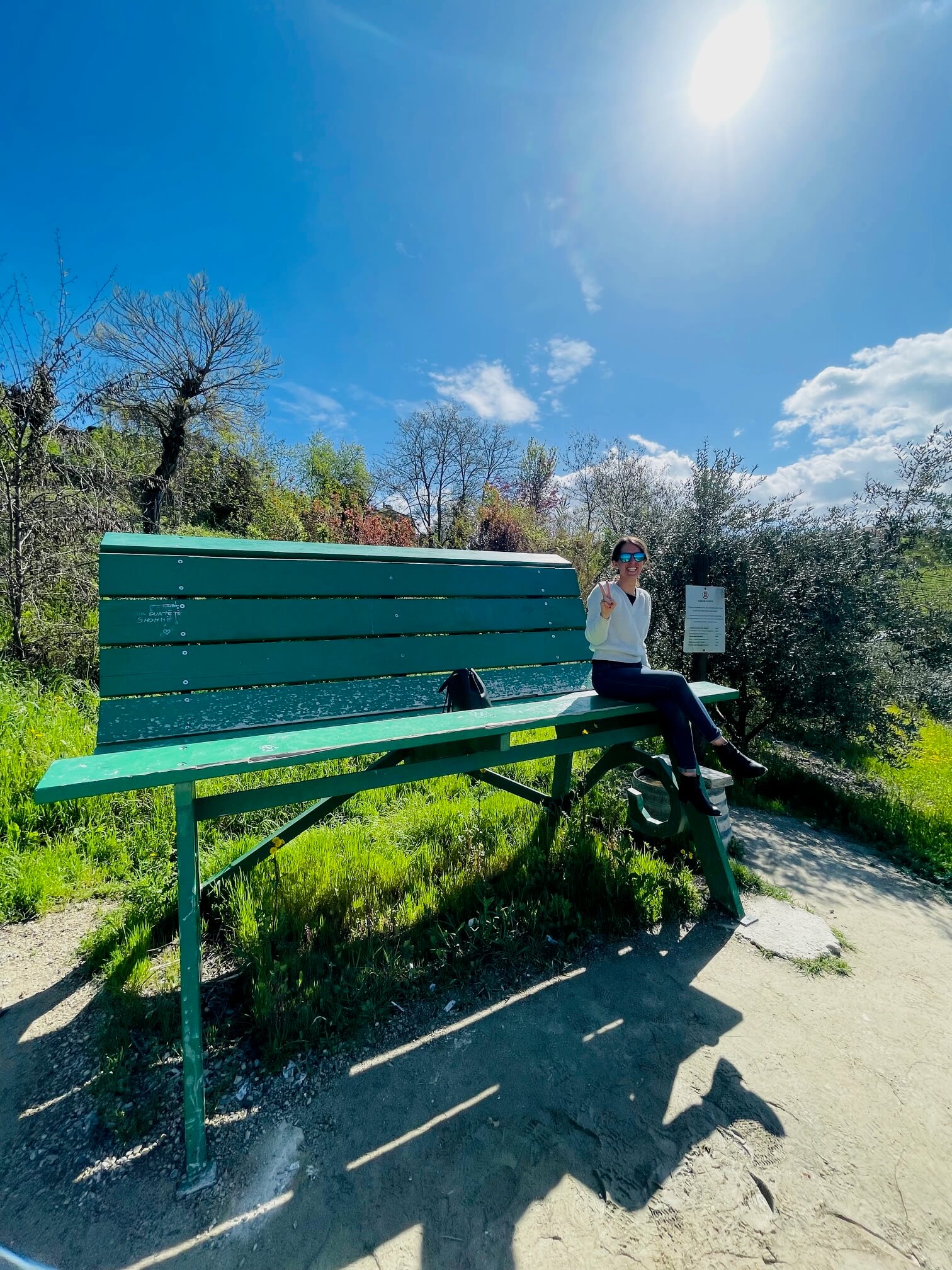
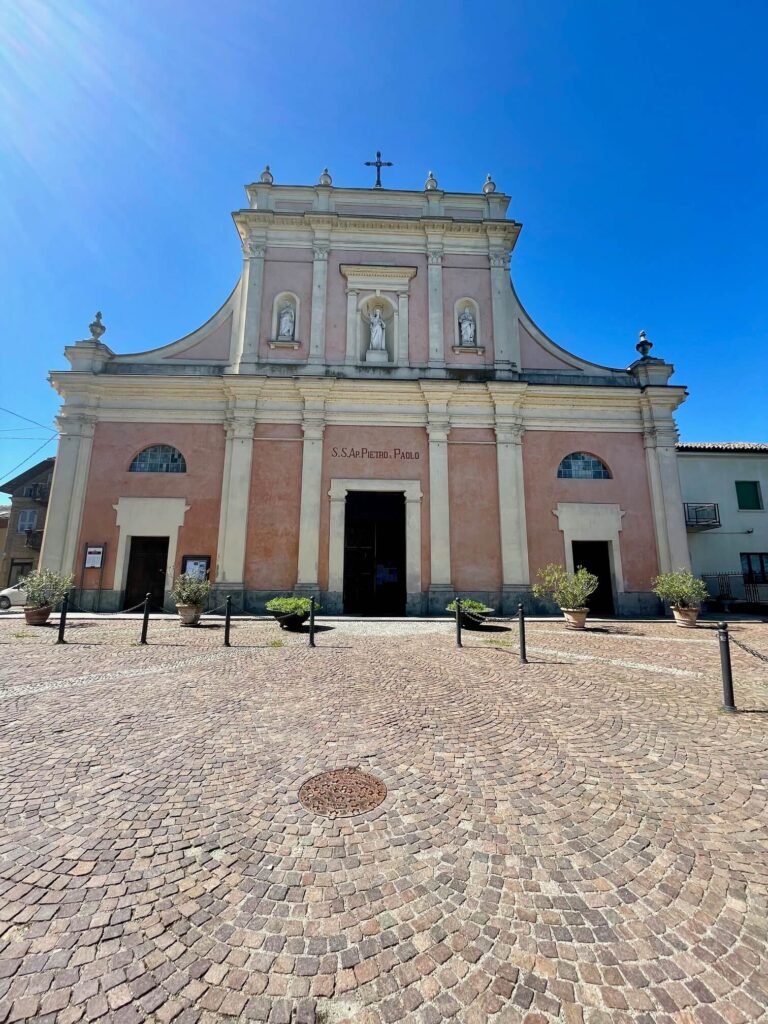
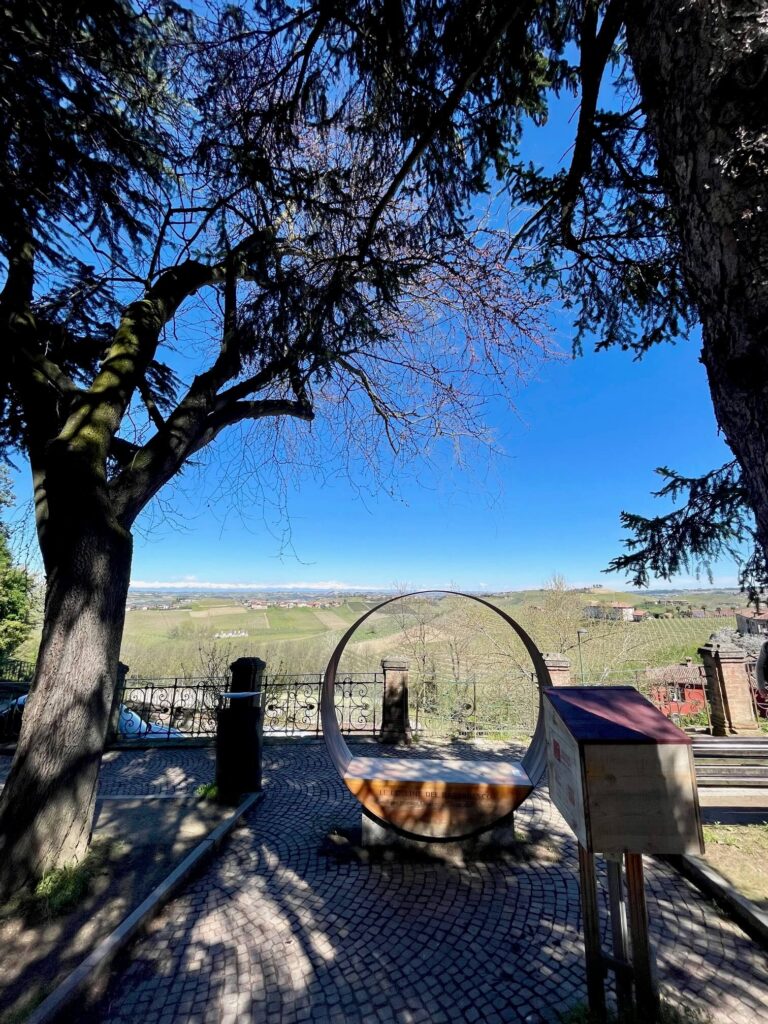
If you continue walking in the inner part of town you will spot the Bell Tower.
You can climb to the top of it, we where a bit unlucky that it was closed when we passed by. In front of the tower there is a beautiful panorama spot. Make sure you don’t miss this.
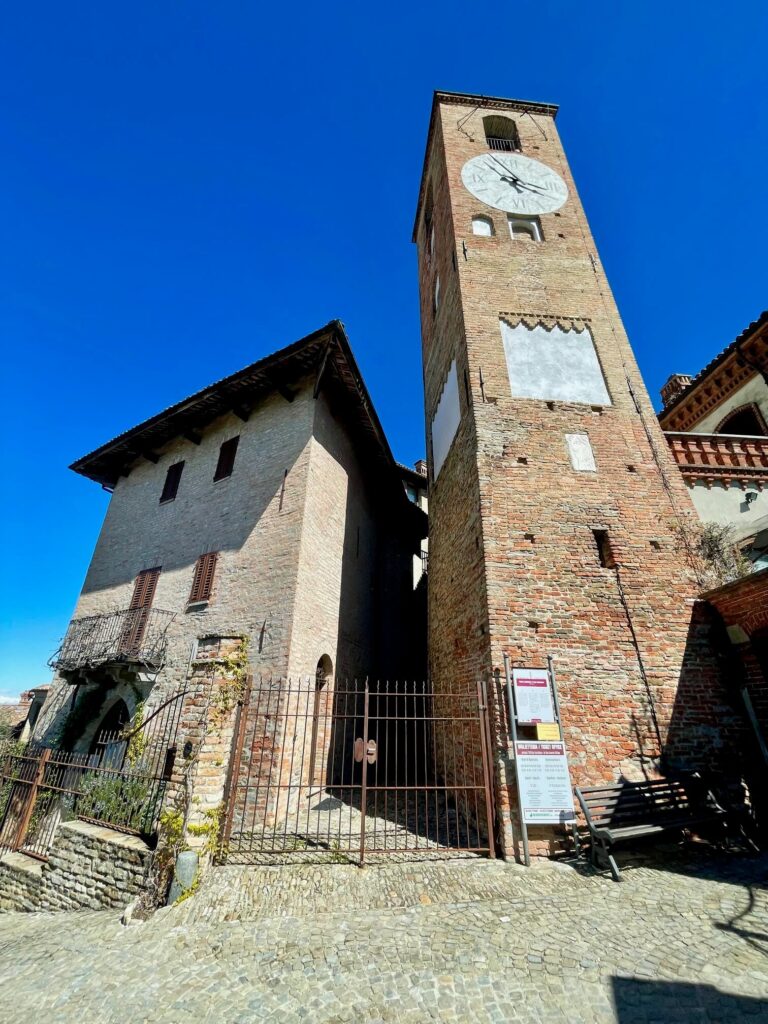
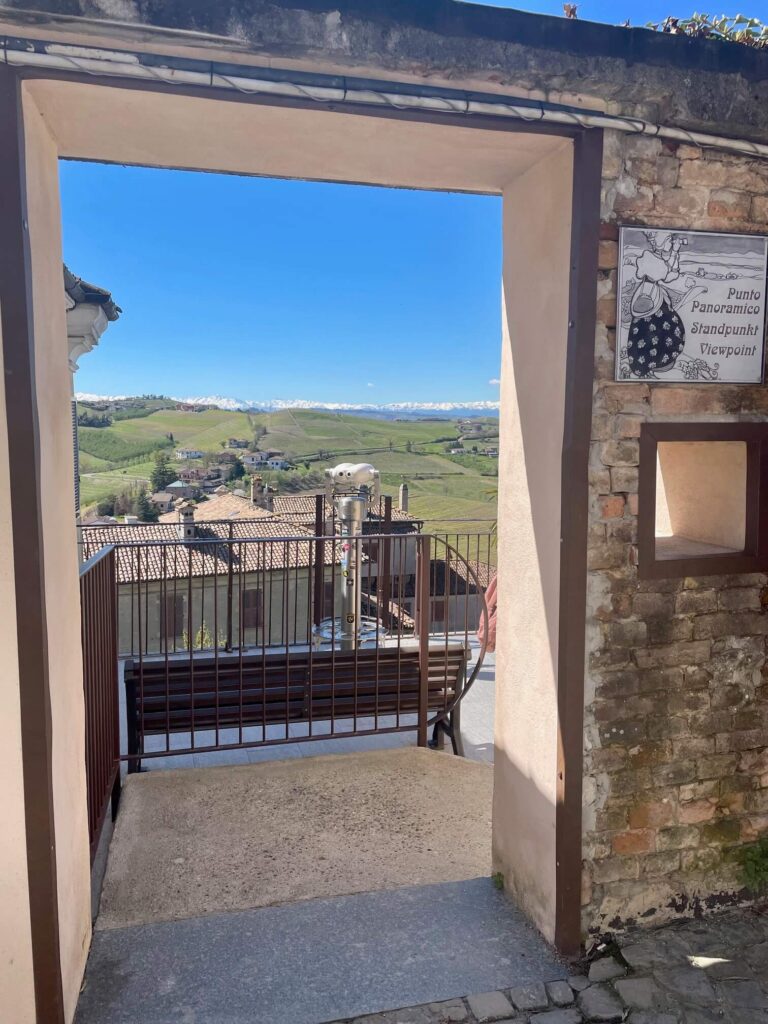
If you keep ging the road will take you to a another square where the town hall and the tourist office are located. The road will then take you back to the main entrance.
I personaly loved the beautiful little houses along the way.
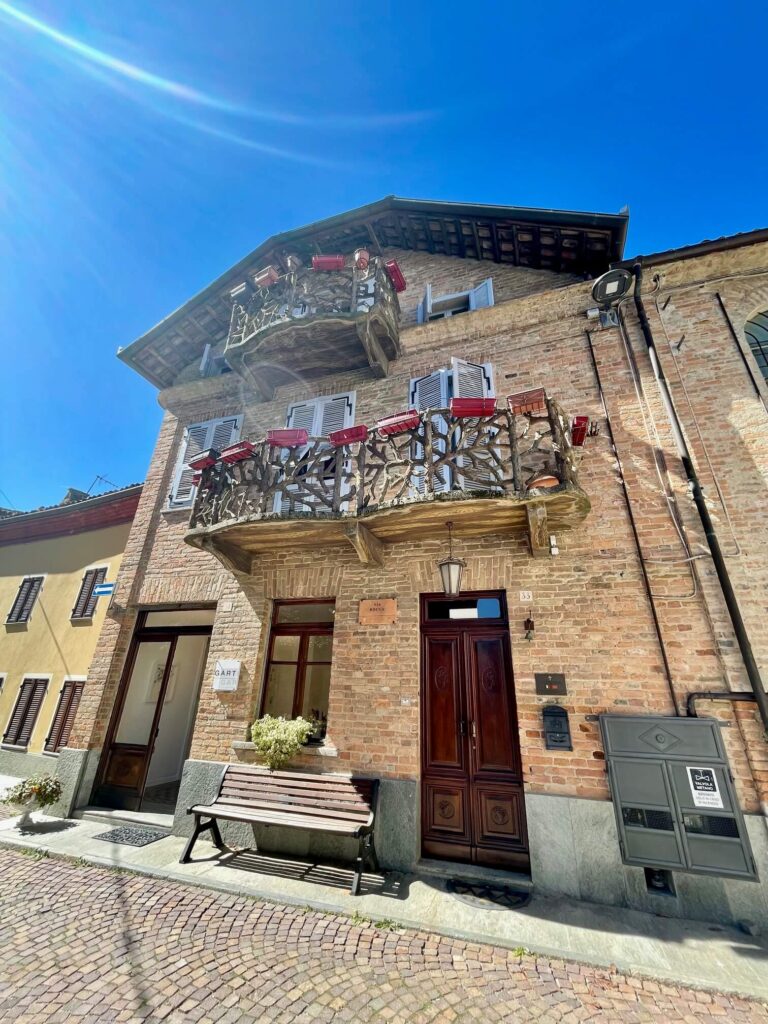
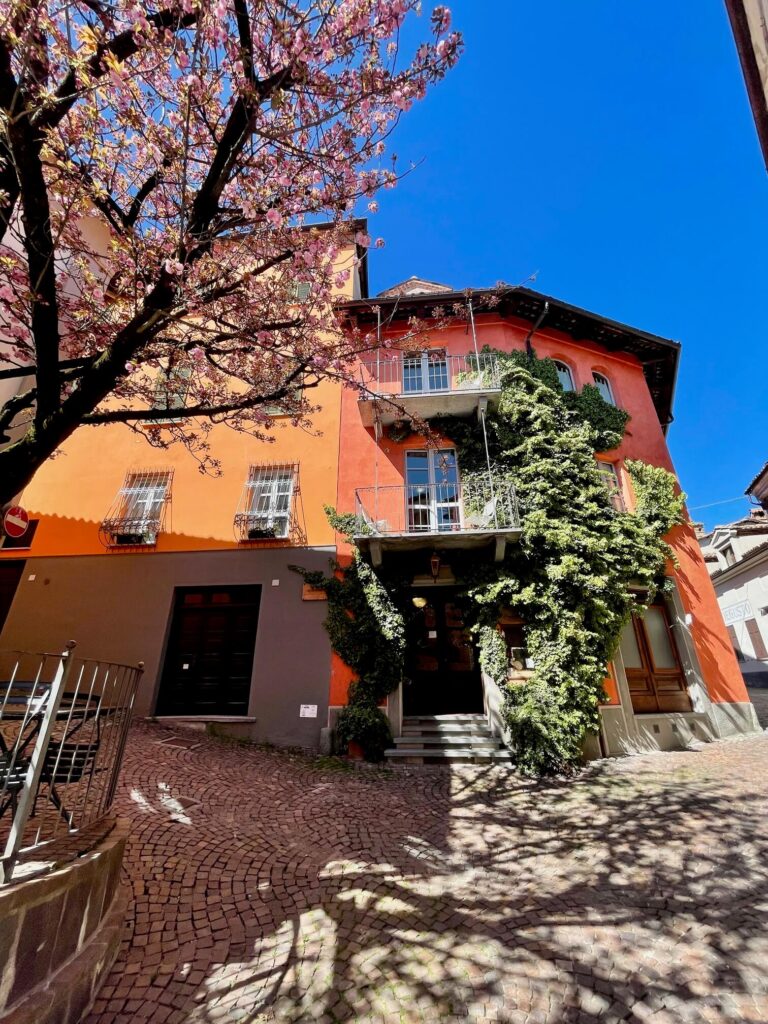
In case you want to stop for lunch I see two options.
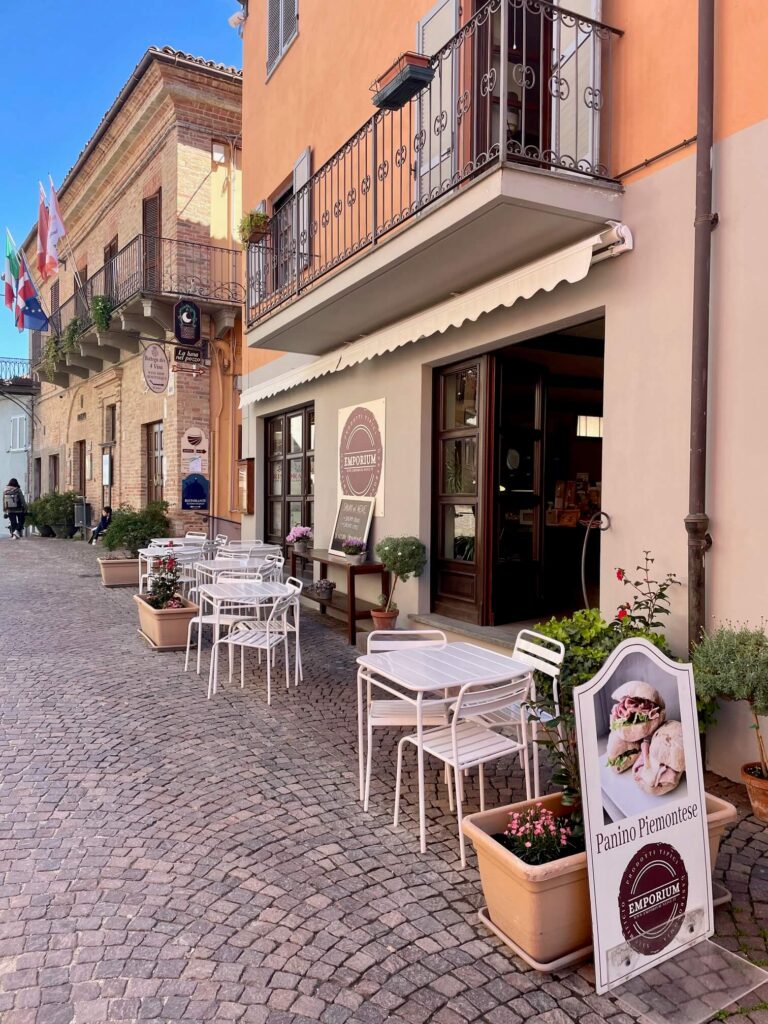
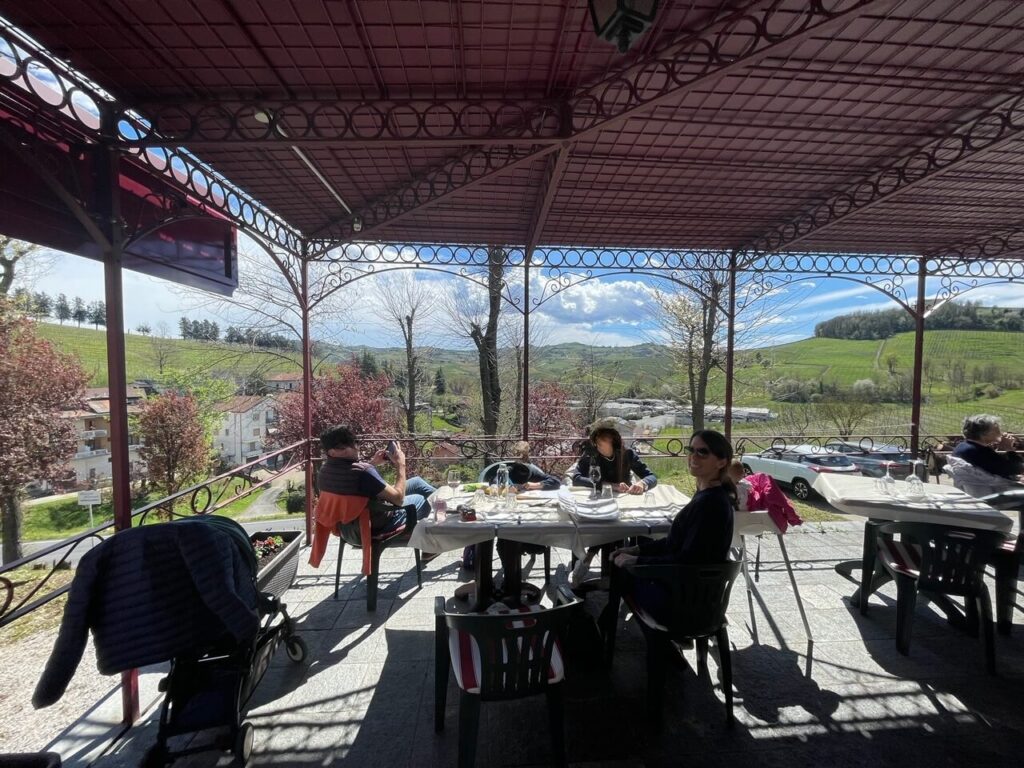
If you’re in a rush or are looking for something light and efficient probably the best option is to grab a sandwich with local cold cuts and cheese in one of the main square. See picture above on the left.
If you have a little bit of time you may want to head back to the car and get to Cantina del Rondo, it is still within the district of Neive but a 10 mins drive from the old town.
As we were not in a rush we went for the second option and we were quite satisfied with it!
As you can see from the picture above on the right, the restaurant has an amazing outdoor terrace with a nice view on the vineyards.
16. One afternoon in Alba Italy
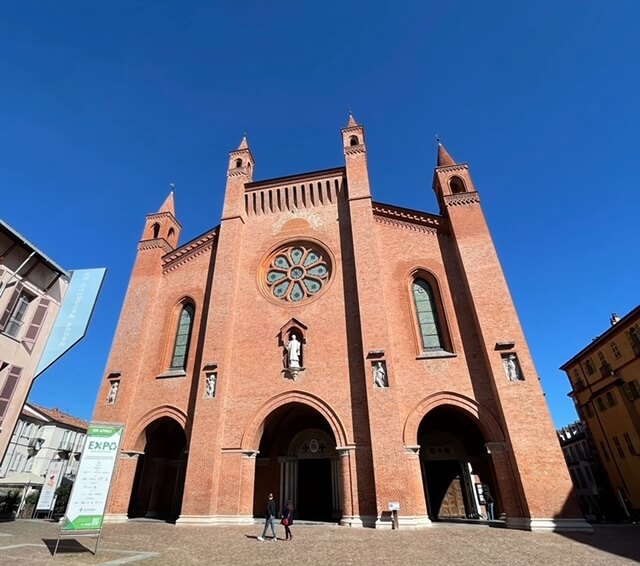
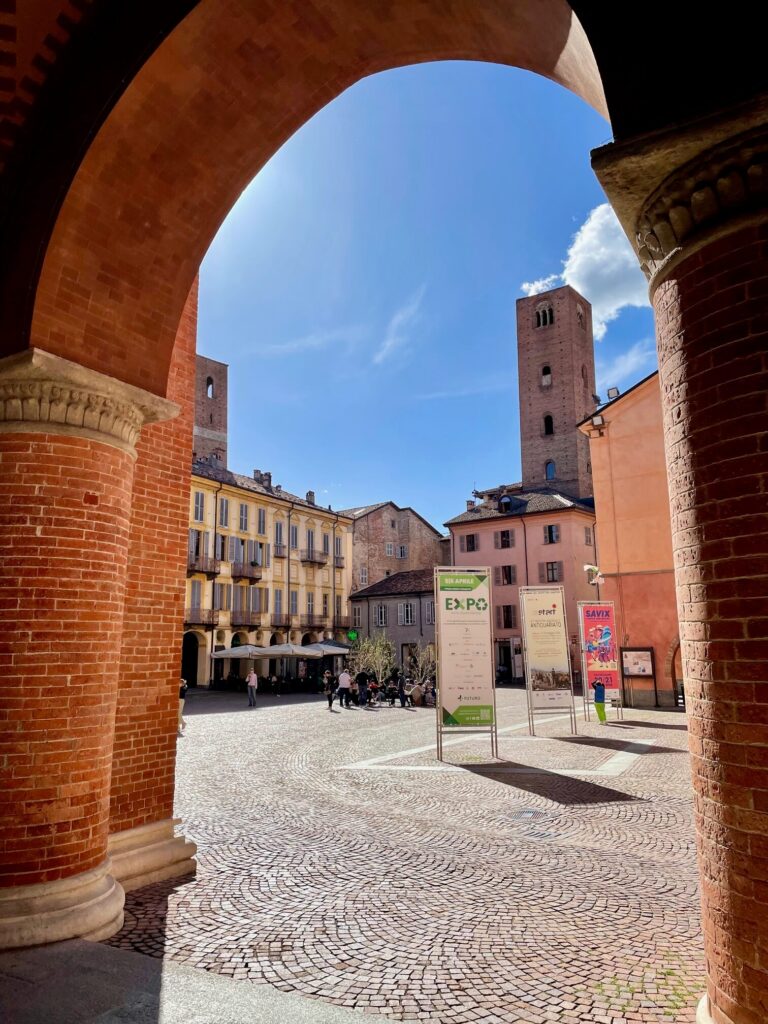
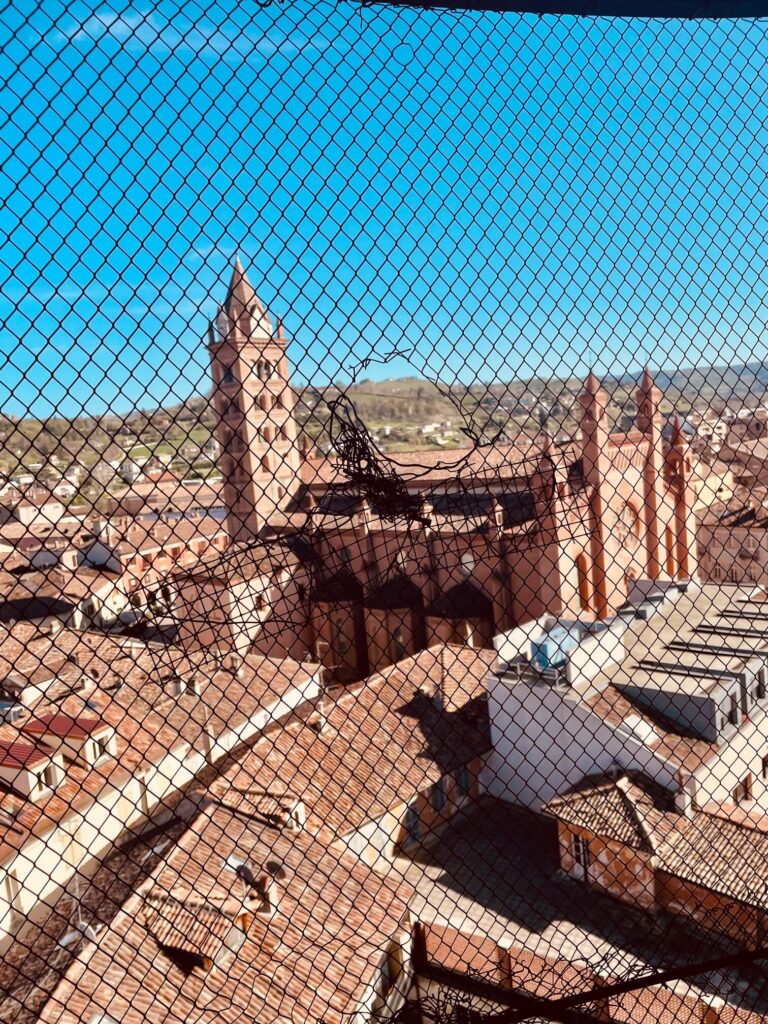
Last but not least, we visited the town of Alba, which is a 15 minutes drive from Barbaresco.
Alba is the biggest village of the area, it is a proper city rather than a village. Nevertheless it is quite beautiful and with tons of pedestrian streets.
The main square is called Piazza del risorgimento, it is a beautiful big square at the center of which is the San Lorenzo Cathedral. The square doesn’t offer the best view of the cathedral, I think the best view is from the top. In my opinion, the cathedral is not the most spectacular one I’ve seen nor the nices in Alba.
My favorite Church interior in Alba and probably in the whole area of Langhe is the church of San Giuseppe. You can see a video below. Truly breath-taking!
The best part however is that for only 2 euros you can climb the bell tower of the San Giuseppe Church. This was really the cherry on the cake! From here you can finally see the Cathedral from the top.
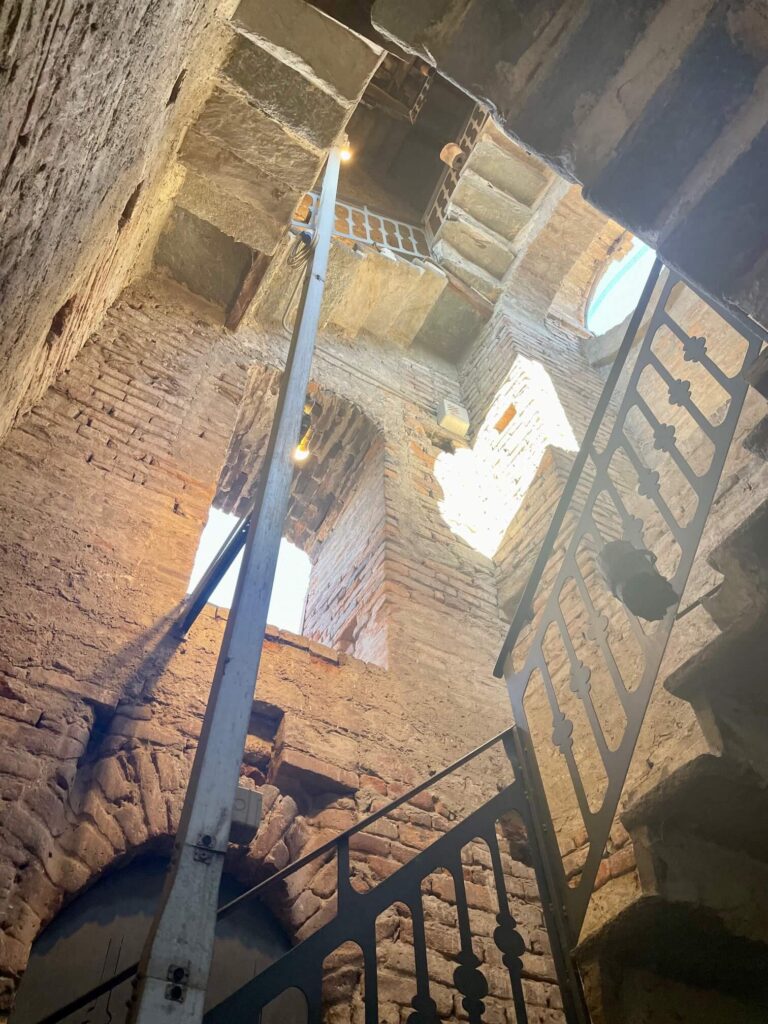
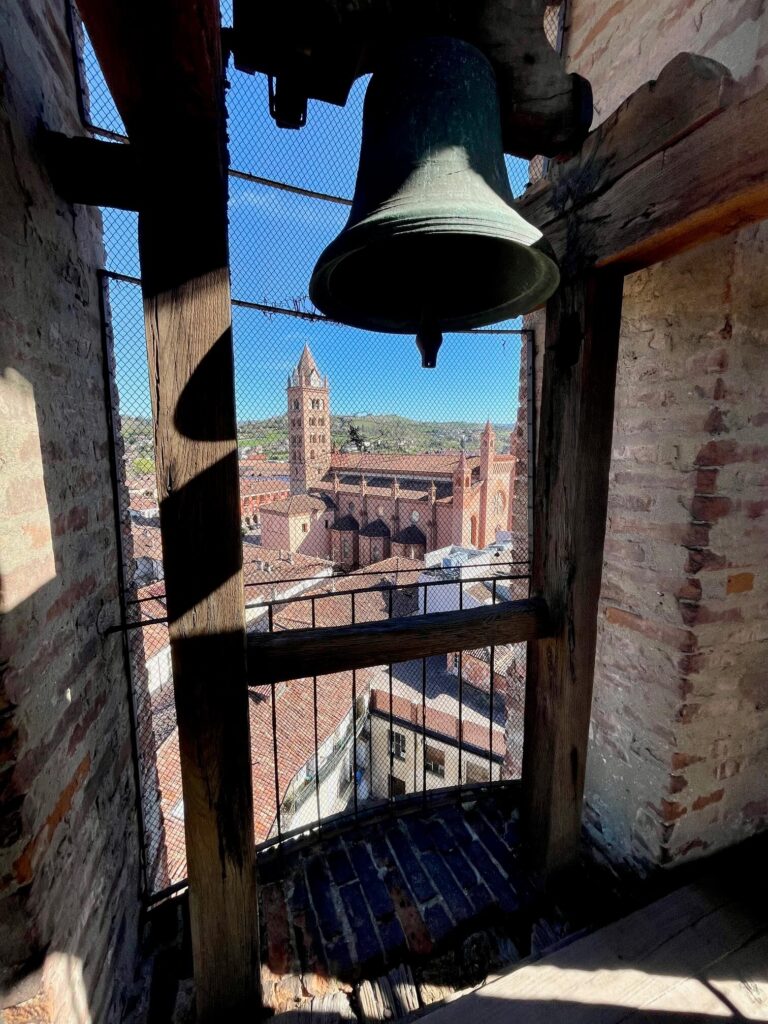
If you have time while in Alba, I suggest you visit the Truffle Museum it costs only 5 euros and you can visit it in 30-60 minutes. You will learn a lot on Truffles that is for sure!
Lastly, you may want to visi the Winery of Pio Cesare for some serious wine tasting.
As mentioned earlier, there is a small part of the Alba area where Barbaresco is cultivated which is called San Rocco Seno d’Elvio. Pio Cesare cultivates Nebbiolo, Barbaresco and they also have some territory also in Barolo. Unfortunately we didn’t have time but we heard some great feedback on this winery!
17. Useful links
Hope you found this post helpful and that you’ll have as much fun as we did.
If you liked this post, please leave a comment and share on your social media. It will help us reach more people & help them having an unforgettable week-end!
- If you want to visit the best beach nearby Langhe, you can read my post on Best Beach near Turin.
- If you’re up for visiting Turin, you can find more details my post Turin One Day Guide from a local
- If you want to learn more on White Truffle, here is a helpful link
Hope you found this post helpful! If you liked it, please share this with your friends via word of mouth and social media!
